
I hope everyone will have a very Merry Christmas and a Happy New Year. And a Happy Hanukkah too!
May you walk gently through the world and know its beauty all the days of your life. ~Apache Blessing
Thanks for stopping in.
Posted in Scenery / Landscapes, tagged Canon SX40 HS, Hancock New Hampshire, Merry Christmas, Snowy Morning on December 23, 2023| 68 Comments »
Posted in Aquatics, Flowers, General gardening, Insects, Nature, Scenery / Landscapes, Wildflowers, tagged Aconite, Antrim New hampshire, Autumn Meadowhawk Dragonfly, Canon SX70 HS, Cheshire Rail Trail, Deer Tongue Grass Fall Color, Fall in New Hampshire, Hancock New Hampshire, Keene, Maple Leaved Viburnum, Monk's Hood, Native Plants, Nature, Nature Study, New Hampshire, New York Aster, NH, November Flowers, November Hikes, November Insects, Oak Leaves, Olympus TG-6, Pickerel Weed, Poplar Fall Color, Silver Maples, Spider Web, Staghorn Sumac Fall Color, Swanzey New Hampshire, Tall Meadow Rue, Virgin's Bower Seed Head, Wetland Insects, Wetland Plants, Wetland Views, Wildlife Sanctuary at Willard Pond, Winterberries on November 4, 2023| 29 Comments »

This post was going to be about the beeches and oaks at Willard Pond in Antrim. For years now I’ve finished the foliage season by visiting this beautiful hardwood forest but this year the light just wasn’t with me on my first visit. This photo has been lightened somewhat so it doesn’t show how dark it really was, especially under the trees. Shooting photos in such conditions would have been a waste of time so I turned and left.

A week later on Halloween I returned to Willard Pond on a cold, blustery morning to find that most of the leaves had fallen. I thought this was a bit odd since Halloween has always been my time to visit but the weather has been strange and unpredictable for all of this year. To be truthful I wasn’t upset that there would be no Willard Pond post this year because the Tudor trail that I usually follow is one of the roughest I know, with a lot of boulders and other things to step over and around. Each time I went I followed the trail for a short while and found that it bothered the knee that I damaged in my recent fall on Pitcher Mountain, so skipping it this year will probably turn out to be the right decision. If you want to see what Willard Pond Forest is like just go up to the search box at the top of the page and type “Willard Pond.” You’ll find several years of posts.

On the road into Willard Pond I saw some beautiful maple leaved viburnums on the side of the road. The color range of these plants is really amazing.

I also saw some bright red winterberries at Willard Pond. The fruits of this native holly hold their color for quite a while so they are sought after by people wanting to use them for holiday decorations. I often find bushes that have had almost all the berry bearing branches cut off.

I think for a while due to leg pain and maybe some balance issues that I should stay on flat, level surfaces like this rail trail in Keene. Other than an occasional woodchuck hole there is little to trip over as long as you stay on the trail. This will not be a hardship because I grew up on this trail way back when it was a working railroad route and I know it as well as I know myself. On this day I went to see the tree colors, which were a bit muted.

The muted colors come naturally because I think there are mostly silver maples in this area. Silver maples turn different shades of yellow in the fall unlike red maples, which have a much wider color range including red and orange.

Though there are still a few isolated red maples showing color most now look like this one.

All the yellow seen in this view comes from beeches, silver maples, birches, and Japanese honeysuckles.

Even the deer tongue grasses turned yellow this year. Quite often I see a lot of purple on these plants.

The silvery, fluffy seedheads of virgin’s bower vines line the rail trail. When in flower they’re known as traveler’s joy but at this stage they’re called Devil’s darning needles. Both names are just meaningless labels we’ve put on a pretty plant. The truth is, in nature there is no good or bad, no right or wrong, no past or future; there is just the perfection of this moment called now. We would do well to learn from this.

In a college botany class I once had I did my final exam paper on poisonous plants. The plant seen here was one of the deadliest, but also one of the most interesting. It is monk’s hood or monkshood; Queen of poisons, and it has been used to kill for countless centuries. If you were found growing it in ancient Rome there was a good chance that you’d be put to death, because as far as the Romans were concerned the only use for the extremely toxic plant was to add its toxic sap to the water of one’s enemies to eliminate them.

A side view of the flowers shows where the name monk’s hood comes from. The plant is in the aconite family and its sap can be absorbed through the skin. In 2015 an experienced gardener in the U.K. died of multiple organ failure after weeding and hoeing near aconite plants. I will often hold a plant steady with one hand while taking a photo with the other hand on windy days but not this plant.
Monkshood plants can stand a lot of cold so it is often one of the last to bloom in this area. The flowers are quite unusual and very pretty but it should only be grown where there are no children present, in my opinion. Knowledge of its dangers and always working around it with gloves on means anyone can grow it. If you do it will certainly be a conversation starter. Just think, you could tell friends how the Roman Agrippina hired Locusta to poison the emperor Claudius I in 54 AD. It is said that Locusta chose aconite to do the deed.

I saw some oak leaves with odd patterns on them. Whether made by insects or caused by nutrient deficiency, I don’t know. There is an insect, a leaf miner I think, which eats all the soft tissue of an oak leaf, leaving just the ribs and a net like skeleton leaf behind.

Some of these photos weren’t used in other posts for whatever reason. One of them is this misty morning visit to the wetlands when the maples were still colorful.

I saw more dewy spider webs on that visit. It’s hard to believe how many large webs are in these trees. This one was about the size of a basketball and I’d say on average that would be the size of most of them.

The colors have been beautiful this year but they’ve also been drawn out because of the warm weather. Everyone I meet seems to have an opinion about what a strange year it has been weather-wise.

The staghorn sumac colors have been amazing this year. The reds especially have been intense. Red is often a tough color for cameras to reproduce accurately but I think this is a fair representation.

Except for the deep purples of ash and oak I can’t think of a single fall leaf color that isn’t represented here in this scene from the wetlands. They’re all there and how beautiful they are when they’re all together in this way. It can take your breath away sometimes.

This is another scene from the wetlands that I like very much. All summer long I thought it would be beautiful in the fall because of the maples, and it was.

In the past the photos I’ve taken of poplars (Aspens) in the fall have almost always been soft and impressionistic as if they had been drawn with pastels, but these trees in the foreground seemed a bit loud to me. In shape and in leaf color poplars look a lot like birches from a distance. Only the gray bark tells the story. Most birches in this area growing in large colonies like that seen here are gray birches, which have white bark.

This is why I call this place the wetlands. The road I walk on was built through a swamp and there is water all along the roadsides. There is abundant life in a swamp and this is an excellent way to stay dry while seeing it.

I’m not sure where else I’d see autumn meadowhawks still flying in November. They were everywhere yesterday, resting in the sunshine. This one landed on a stump right in front of me and I had to wonder if they could read minds. I also saw lots of bluebirds on this day but I couldn’t get any of them to pose.

I was surprised to see a few pickerel weed flowers blooming in the wetlands after all others in various places had gone to seed. I have to say that this spot is a real jewel, with an abundance of birds, animals, insects, and interesting plants and wildflowers. There’s really no telling what you’ll see on any given day and I’m very happy to have finally discovered it, right there alongside the Keene Airport of all places. The level, paved road is easy to walk but there are plenty of places where you can leave it and explore the forest.

It was there in the wetlands that I saw the fall colors of tall meadow rue for the first time. This plant always blooms just at or before July 4th with flowers that look like bursts of fireworks. The “tall” part of its common name is very true; I’ve seen it reach over seven feet.

Since we had snow flurries as I was writing parts of this post I’ll end it with a white aster. We’ve also had our first freeze, almost a month late and coming before the first frost that should have happened in mid-September. Oh well, since a friend in Michigan reported 10 inches of snow on Halloween I don’t think we have anything to complain about.
An autumn forest is such a place that once entered you never look for the exit. ~Mehmet Murat ildan
Thanks for coming by.
Posted in Nature, Scenery / Landscapes, tagged Arrowwood Viburnum, Ashuelot River, Beaver Brook Fall Color, Beaver Brook Natural Area, Bee on Daisy, Blue Stemmed Goldenrod, Branch River, Canon SX70 HS, Cinnamon Fer in Fall, Dublin New Hampshire, Fall Asters, Fall Color, Fall Flowers, Fall Forest Color, Fragrant White Water Liliy, Half Moon Pond, Hancock New Hampshire, Howe Reservoirs, Keene, Maple Leaved Viburnum, Marlborogh New Hampshire, Native Plants, Nature, Nature Study, New Hampshire, NH, Olympus TG-6, Poison Ivy in Fall, Red Maple Fall Color, Red Maple in Fall, Solomon's Seal Berries, Surry Dam, Surry New Hampshire, Swanzey New Hampshire, Territorial Owl on October 14, 2023| 37 Comments »

The trees have transformed themselves with blazing color almost overnight this year, and the leaf peepers are here to see them. “Leaf peeper” is what all the tourists who come to see the fall colors are called. For about a month millions of them come and swell the population of the state to twice its size, and they are loved by the people who live here. They stand in awe of the colors with looks of amazement and wonder on their faces and we locals stand right there beside them with the same look on our faces, because no matter how many times we’ve seen this it’s still amazingly beautiful. It’s like being inside a kaleidoscope.

This year I thought I’d take you on a popular leaf peeper mini tour, heading east out of Keene on Rte. 101. There are lots of maple trees along this stretch and maples usually turn earlier than most other trees. Red maples especially have a wide color range and can be yellow, orange, red and sometimes even pink. This shot shows the Branch River on the way to Marlboro on a recent cloudy day. It’s one of my favorite stops to see early color. By the time the oaks and beeches come ablaze most of the trees here in this view have dropped their leaves.

Another thing I sometimes do in these fall color posts is take two shots of the same scene; one under cloudy skies and one in full sunshine. I do this because I’ve always thought that the colors were richer and more vibrant on cloudy days but to be honest that could simply be my eye trouble, because there are lots of people who think brilliant sunshine best shows the colors. It doesn’t matter because it’s all beautiful, but I’ve put some of both sunny and cloudy skies in here and there and I’ll let you decide.

On Rte. 101 in Marlboro as you’re traveling towards Dublin there is a cow pasture on the right and you can often see a line of cars parked alongside the road. The hillside on the other side of the pasture is the reason why, as you can see. It’s one of the most colorful and beautiful places to see along this road in the fall.

Leaving Marlboro and into Dublin is Howe Reservoir, where can be seen more beautiful color from maples. I went twice, once on a cloudy day which is seen above and once on a sunny day. Again, I think the colors “pop” more on cloudy days but one drawback at this particular spot is that clouds will often obscure the view of Mount Monadnock.

This is essentially a continuation of the previous shot, followed to the right. There are beautiful colors here this year.

Here is a view of Mount Monadnock from Howe Reservoir that I spoke of, taken in full sunshine. Once again, I’ll let you decide what you like best.

Here is a red maple that stands just at the edge of Howe Reservoir. In the fall red maples aren’t always red.

I took a left turn onto Rte. 137 in Dublin, heading for Hancock, and stopped at Half Moon Pond where I discovered that the view was very different from this spot than it used to be in the morning before work. At 6:30 am the sun is just coming up over the hills that were behind me, and it falls on the strip of colorful trees there at the edge of the water and lights them up as if they were on fire. I used to stop almost every morning at dawn just to see it happening. On this day the deep colors were bleached out by the bright sunshine. Two geese quickly swam away, apparently upset that I interrupted them. I’ve seen and heard geese flying overhead in formation as well.

There was color along the Nubanusit River in Hancock. This is another stop that I used to sometimes make in the morning.

I used to also drive by this tree every morning, so I could watch it go from hints of color to color on every leaf; another fine example of a red maple in the fall. Without red maples this would be a very different landscape, especially at this time of year. Old timers call these trees “swamp maples” but if you look for that name in a tree identification guide you won’t find it.
From here you can go through the small town of Hancock and return to Keene by way of Rte. 9 south, or you can go back the way we came. Either way it really doesn’t matter because there is glorious color everywhere, along all roads. The big difference between routes is how many places you can stop and get out of the car. I think the way we came on Rte. 101 has more opportunities for doing so.

I thought we could take a rest from the road for a bit and look at few other things that are part of fall in this part of the world, like this beautiful fragrant white waterlily leaf. I loved it for its beautiful color and its veining. It was one leaf on a plant with many leaves and all were green except this one, which dared to be different.

And this will most likely be the last fragrant white waterlily bloom we’ll see until next spring. I took the photo about three weeks ago, I think.

Poison ivy is beautifully red this year. You might want to touch it or pick a few leaves to dry or press, but you might want to think that over because unless you’re immune to its toxins you’ll itch like mad for a week or two. Once it’s on your hands it can spread to other parts of the body and before you know it you have it all over you. The old saying leaves of three, let them be, is true.

Growing up out of the large bed of poison ivy was a Solomon’s seal plant with fruit dangling under the leaves. I’ve tried and tried to get a shot of the berries for years without much satisfaction but this year I decided to use my cell phone and the shot I got with it is what you see here. Very carefully, without touching any leaves, I reached up and over the poison ivy, and I haven’t itched at all.

I stopped to see the asters that grow in a local park one day and I think I saw as many bees as I did flowers. We hear a lot of bad news about bees and I can’t say whether it is right or wrong, but I do know that I’ve seen more bees this summer than I can ever remember seeing. If you look closely you’ll see them in this photo. Honeybees, I believe.

Here is a close look at one of those bees. I wanted to show you the open (true) flowers of a daisy and along came this accommodating bee to show you how they worked. This is a Montauk daisy which also grows in the park, and which was originally developed in Japan. For that reason it is also called the Nippon daisy. It is like a Shasta daisy on steroids and is very hardy. I saw them blooming in a snowstorm one year in late fall.

I went to Robin Hood Park in Keene and just as I got to the trail entrance I saw this sign. Attack owl or not I would follow this trail. As I walked along I could hear the flapping of wings, as if a bird sat in a tree above and was flapping its wings, but I never saw the source of the sound and I never saw an owl.

I wanted to follow the trail because lots of maple leaved viburnums grow here, and they’re beautiful at this time of year. They come in a wide range of colors and these examples were a kind of orangey pink.

And these were a deep purple, which is my favorite. If you’re looking for a native shrub that will attract birds and other wildlife and put on a good show in the fall, you might want to consider maple leaved viburnums. They’re a “plant it and forget it” shrub that ask for nothing except an hour or two of sunlight. Here at the park they grow in the shade of old white pines, maples, and oaks.

The next day was cloudy, so I visited the Army Corps of Engineer’s Dam in Surry for this view of one of the hillsides that was blasted during the dam’s construction. It was too dim on this overcast evening for the Canon camera that I often use for landscapes so I used one of the cell phone cameras, which do better in low light. It was the evening light that was important because in this light the color of the stone changes from ash gray to the beautiful blue gray color seen here. The contrast between the blue of the stone and the many colored shrubs / trees is beautiful and I could have stood here enjoying the scene for much longer if the sun hadn’t been going down. It’s one of my favorite places to come in the fall because it speaks of the beauty that can be found in wilderness. Or what was once wilderness; if you somehow tumbled down this slope today you’d end up in the dam’s spillway, so let’s make sure that doesn’t happen. If memory serves me correctly some teenagers climbed the safety fences one day and had to be rescued from this slope.

Surry dam dams up the Ashuelot river enough to create Ashuelot Lake behind it, but what trickles through is once again called the Ashuelot River, seen here just after it leaves the dam and begins its run through Bretwood golf course.

I headed south from Surry and once again ended up back in Keene, where I stopped at the Ashuelot River again. Following the trail through Ashuelot Park that winds alongside the river, I came upon this scene. As you could see there was a cloudless sky and it was too bad I thought, that the sun shined so brightly.

I was surprised to see an arrowwood viburnum still full of berries. The birds usually strip them of the pretty berries as soon as they ripen.

I went to a spot where many cinnamon ferns grow to see if they had turned pumpkin orange yet. They had, and they were beautiful.

I remembered that I hadn’t gone up to Beaver Brook natural area in Keene to see the only examples of blue stemmed goldenrod, so I went there to see it. The only trouble was, its stems weren’t blue. The blue color comes from the same naturally occurring wax crystals that cause the “bloom” on plums, blueberries and many other things found in nature. A lot of heat can melt them and a lot of rain can wash them away, and we’ve had both. If you look closely though you can see a hint of a blue stem running just over the leaf litter under this flowering stem.

Beaver brook was as beautiful as ever, and I knew I’d have to come back when I had time to walk the full length of the road. There are lots of oaks and beeches here and as I’ve said elsewhere in this post, they’re beautiful trees in the fall.
So you’ve seen the slice of fall color in the south western corner of New Hampshire for this week but we’re just getting started, so there will be plenty more to see.
Mere color, unspoiled by meaning, and unallied with definite form, can speak to the soul in a thousand different ways. ~Oscar Wilde
Thanks for stopping in.
Posted in Fungi, Slime Molds, tagged Black Tooth Fungus, Butter Waxcap Mushroom, Canon SX70 HS, Chanterelle Mushroom, Coral Mushrooms, Crimson Waxcaps, Fungi, Hancock New Hampshire, Hemlock Varnish Shelf Fungus, Hen of the Woods Mushroom, Indian Pipes, Insect Egg Slime Mold, Jelly Baby Fungus, Keene, Native Plants, Nature, Nature Study, New Hampshire, NH, Olympus TG-7, Orange Unicorn Mushroom, Painted Suillus Fungus, Pinesap, Purple Cort Mushroom, Purple Trumpet Mushroom, Russell's Bolete, Slime mold plasmodium, Summer Fungi, Swanzey New Hampshire, Yellow Spindle Coral Mushroom on October 7, 2023| 30 Comments »

I’ve had a hard time getting to this mushroom post because so many other things have been showing themselves, but things are calming down now so I’ve finally put this one together. I say finally because I found most of what you’ll see here in August when it rained frequently for a week or so. I’m starting of with these cute little orange unicorn mushrooms (Entoloma quadratum.) Though I don’t see any orange in them my color finding software does, so I believe the name is correct. The unicorn part of the name comes from the tiny knob at the top of the cap. These mushrooms aren’t common here but I see a handful each year.

I’ve seen lots of coral fungi lately, especially yellow spindle coral (Clavulinopsis fusiformis) like that seen here. They always remind me of tiny flames coming up out of the earth. I often see them coming up along the sides of hard packed trails.

Quite often when looking for mushrooms you’ll find at least one that can’t be identified and this is one of those. You have to look at branching or forking and tip formation in coral fungi but there was very little of either going on here so all I can say is it’s a type of club or finger coral. At first I thought they were a worm coral but a close look showed a bit of branching going on.

Purple cort mushrooms (Cortinarius iodeoides) are covered with a bitter slime that keeps critters from damaging them. I’ve tried unsuccessfully for years to get a photo of the slime so I could show it to you. This year I finally pulled it off; you can see the liquid like reflections on this cap, though there isn’t really any liquid there. If you picked it you would find it cold and slimy; that’s the only way to describe it. The slime does dry as they age and then slugs will start eating them.

Butter wax caps (Hygrocybe ceracea) are usually one of the most photogenic of all the smaller mushrooms but these were ragged, and I’m not sure why. I didn’t see any real good examples of how beautiful this mushroom can be this year.

I saw just a single hen of the woods mushroom (Grifola frondosa) this year and this is it. It was young and not well developed but it was interesting just the same. They are also called ram’s head or sheep’s head in this country and in Japan they are known as the dancing mushroom. They are said to look like the back of a brown hen’s ruffled feathers, and that’s how they come by their common name. I’m a little baffled by mushrooms this year. We had more rain than I can remember so I thought there would be mushrooms everywhere, but that hasn’t been the case. Can we have too much rain even for mushrooms?

I know that Indian pipes (Monotropa uniflora) aren’t mushrooms but since they always appear along with mushrooms I usually include them in the same posts. It is fitting that the plant appears in a post on fungi because according to the University of Texas Indian pipes are associated with a fungus which obtains nutrients directly from the roots of green plants. That makes Indian pipe a parasite, with the fungus acting as a “bridge” between it and its host.

Another plant that is similar to Indian pipes is called pinesap (Monotropa hypopitys) It would be hard because of its color, to confuse these examples with Indian pipes but they can often be very light colored and can look the same at a glance. The surest way to know which plant you’re looking at is to count the flowers. The word uniflora in the scientific name of Indian pipes means “one flower” and that says it all; there is a single flower per stem. But on pinesap plants, as can be seen here, there are multiple flowers per stem. These plants receive nutrients from fungi that are associated with the roots of oaks and pines. They aren’t as common as Indian pipes so some years I don’t see them at all.

Hemlock varnish shelf fungi (Ganoderma tsugae) are probably the most easily found in this post. This was a good year for them and I saw trees with a dozen or more on them. Though they’re usually the size of saucers, I’ve seen them reach dinner plate size. This mushroom is considered the most important of all the herbs and substances used in Chinese herbal medicine, including ginseng. In China it is called the reishi mushroom and scientists around the world are researching its anti-cancer potential.

I’ve seen a lot of slime molds this year but almost all of them have been insect egg slime molds (Leocarpus fragilis) like that seen here. Each “egg,” about the same diameter as a common pin, is actually a fruiting body of the slime mold. Each one is on a stalk that can’t be seen here, and as they age they will blacken and harden, and start to crack open before releasing their spores to the wind.

In this view of another insect egg slime mold it has come together from the more liquid plasmodium stage and is in the process of separating into individual fruiting bodies. You can see just a few have separated out from the main mass. When finished the mass will look like what we just saw in the previous photo.

In this view of a slime mold taken earlier the slime mold is in the plasmodium stage, which happens before the stage in the previous photo. In this stage it is close to liquid and moves over the forest floor looking for yeasts, mushroom spores or bacteria to feed on. This movement is called “streaming” and happens at about 1 millimeter per hour. The plasmodium is made up of networks of protoplasmic veins and many nuclei which move to seek out food. Once the slime mold finds something it likes it comes together and surrounds it, and secretes enzymes to digest it. The easiest way for me to think of slime molds is as a single celled organism like an amoeba, with thousands of nuclei but in truth nobody can say what they really are. Though it can spread itself out over a large area the slime mold’s parts all move together as one, as a flock of birds or a school of fish would. They are fascinating and beautiful at the same time.
I have traveled backwards through a slime mold’s life cycle with these photos, so this photo would show stage one. Stage three, the final stage before spore production, would actually be two photos ago, if that makes sense.

I can’t swear to the fact and I have no scientific proof but experience has shown that when I see leaves colored in this way I am more likely to find slime molds; especially if the leaves are oak leaves.

The black tooth fungus (Phellodon niger) is easy to just pass by but it is an interesting mushroom that can vary in color. I’ve seen them almost black as these were and I’ve seen them in maroon. If they grow close enough together their caps can fuse together, creating a large misshapen mass. Of course they also grow singly. Another odd thing about this mushroom is how the caps seem to split open as they age. If you pick one you notice immediately how tough and dense it is; almost as if it has more weight than its size would permit. Finally, when it is turned over you see the black “teeth” that give it its common name. The teeth are really just folds of tissue and spores form on them. It’s interesting how the spore bearing surface increases when a mushroom grows pores or spines on its cap. All in all this ho-hum mushroom that people walk right by with hardly a glance really bears a second look, because it’s quite an interesting mushroom.

When I see a mushroom that looks like this I immediately think “chanterelle” but would I eat them? Not a chance. I’ve read and heard so many conflicting arguments for and against chanterelles and false chanterelles, summer chanterelles and winter chanterelles that I don’t know if I’d eat them even if an expert gave them their blessing. One of the most striking things about the mushroom in this photo is its hollow stem. But chanterelles have solid stems, right? Well, yes and no; yellow foot chanterelles have a hollow stem. In fact, DNA analysis has shown over 20 chanterelle species are at least partially hollow, and that’s just in the U.S., so the old solid stem argument doesn’t really hold water.

From the side this sure looks like a chanterelle but do we know the difference between false gills and true gills? Do the gills branch or do they run straight? Are they blunt where they meet the stem or do they just kind of fade? Are they the same color as the cap and stem? What color should the stem be?
Rather than trying to discourage anyone from eating mushrooms, I’m trying to show people what they should know so they can be sure what you’re eating is safe. In the case of chanterelles eating a big dish of false chanterelles won’t kill you, but it will make you sick enough to never want to do it again. The simple point is, know what you’re eating. If you can’t be 100% sure, don’t eat it; and that applies to not just mushrooms but any wild food. The best way to learn in my opinion, is to find someone who leads foraging hikes and tag along with them. You’ll learn more in an afternoon than you would have thought possible.

On the other hand, there are edible, choice mushrooms that you can be sure of just by their looks, and the purple trumpet (Craterellus cornucopioides) is one of those. I usually find them on south facing forested slopes under deciduous trees like beech, oak, and maple. They are also called black trumpets, blue trumpets, or blue chanterelles. They appear in this area near the end of August and are considered a delicacy. I’ve met foragers at this time of year whose first question is often “Have you seen any purple trumpets?” That’s because, if you walk into a restaurant kitchen with a bag full of these, you’ll likely walk out with a pocket full of cash, and that’s how professional foragers earn their living. Last I heard they were going for $50.00 per pound, but that was a couple of years ago I think. Purple trumpets are especially prized by chefs because they dry easily and they hold their flavor when dried, and they can be chopped, powdered or what have you. I’ve seen hillsides covered with so many of them you could hardly walk without stepping on them, but since I’m not a forager I just let them be.

Jelly babies (Leotia lubrica) helped me see that forests are full of small and beautiful things. Once you train your eyes to see small things, before long a previously unseen side of nature will suddenly appear. Despite their name jelly babies are sac fungi rather than jelly fungi.

I saw lots of red painted suillus mushrooms (Suillus spraguei) this year. For about a month they were everywhere I went. They are also called the painted slippery cap and red and yellow suillus. The caps are dark red when young and develop yellowish cracks as they age. They also have mats of reddish hairs on the cap as can be seen here.

Cotton like hairs on the underside of the painted suillus cap are actually a partial veil that covers the spore bearing surface when the mushroom is young.

In this shot taken previously you can see the yellowish elongated pores that are revealed when the partial veil pulls away. All of these features combined make this a very pretty mushroom that can indeed look like it was painted. These features also make it very easy to identify and the fact that it is a common mushroom makes it easy to find. That means it’s a good starting point in mushroom identification. They start to appear in mid-August and will be around through October, usually. Look for them near and under pines.

It’s hard to miss a Russell’s bolete (Boletellus russellii) if you look at its shaggy stem with its deep grooves and angular ridges. Why would a mushroom evolve a stem like this? The only thing I can guess is to impede slugs crawling up the stalk. The “yellow-brown to reddish-brown to olive-gray cap” is often scaly and sometimes cracked.

Though there are gilled boletes most have pores, as can be seen on the underside of a Russell’s bolete. The color or the surface is yellowish, becoming more yellow if it is bruised. You can see brighter yellow around the edges of the cap in this shot. The pores or tubes are very angular.

One recent morning I went out into the yard and found these crimson waxcaps (Hygrocybe punicea) under a hemlock tree at the edge of the forest. They were glowing with the light that is in all things, and I took several photos from different angles, trying to show you that glow. I do these mushroom posts in the hope that you’ll see their beauty more than their usefulness. To me they’re every bit as beautiful as flowers, but I’m noticing that people don’t seem to be as interested in mushroom posts as they once were. I thought the other day that if people could see nature just as it is before opinions and suppositions cloud their view, then they might discover the pure joy of seeing nature as a child does. If you’re lucky enough to have a two year old just walk through nature with them and watch and learn what seeing truly is, and what true joy and love are, and then find the child within yourself.
I love nature, I just don’t want to get any of it on me. ~Woody Allen
Thanks for coming by.
Posted in Aquatics, Flowers, Insects, Nature, Scenery / Landscapes, Wildflowers, tagged Arrowhead Blossoms, Ashuelot Falls, Atlantis Fritillary Butterfly, Beauty in Nature, Blue Toadflax, Blue Vervain, Butterfly Eyes, Canon SX70 HS, Doll's Eyes, Garden Phlox, Great Blue Heron, Great Spangled Fritillary Butterfly, Half Moon Pond, Hancock New Hampshire, Hobblebush Fall Colors, Keene, Late Summer Flowers, Monarch Butterfly, Native Plants, Nature, Nature Study, New Hampshire, NH, Obedient plant, Olympus TG-6, Purple Aster, Roadside Wildflowers, Summer Aquatic Plants, Summer Flowers, Summer Hiking, Swanzey New Hampshire, Tall Phlox, Tansy, Turtlehead with Mildew, White Admiral Butterfly, White Ash Fall Colors, White Baneberry on September 2, 2023| 28 Comments »

Now that fall is almost here we’re having some summer weather so I’m getting out more. I went to where I used to work in Hancock recently and one of the first things I stopped to admire was this view of Half Moon Pond. For seven years I started each work day standing in this spot, looking out over the pond and drinking in the quiet. Since I grew up awash in quiet that part of the job was a perfect fit from the first day. The experience was a unique one for me though, because working so close to the pond meant I could watch all of its changes as they happend. It reinforced what I’d had an inkling of as a boy growing up along the Ashuelot River; life is a circle and from hour to hour, day to day, and year to year it is in a state of constant change, like a great wheel slowly turning. Following that lead you discover something that is unchanging, and it is found inside us all.

As I was leaving Hancock I saw a small stream with its banks full of flowers of all kinds. There were white asters, pink Joe Pye weed, purple loosestrife, white boneset, and yellow goldenrod growing there. It was a natural garden; a beautiful spot.

There were flowers everywhere, like a roadside Monet painting. Who needs riches when we have places like this? We are already rich, but most of us don’t see it.

I didn’t see any purple asters there but I am starting to see them in other places.

I’m also starting to see monarch butterflies, but not here in Keene. This one was in Hancock, probing for nutrients in a gravel road. There seem to be few to none in Keene this year.

I also saw a white admiral that day, looking a bit tired. In fact I thought it might have died but it slowly lifted its wings when I moved closer so I knew it was alive. I took a couple of shots and moved away to let it rest.

The clear white flowers of arrowhead have appeared. Each one of these had tiny flea like black insects on it but since they grew just offshore I couldn’t get close enough to see what they were. The centers of the flowers look like little clown noses.

There are plenty of great spangled fritillary butterflies in Keene. They love Joe Pye weed, and we have lots of it.

Great Spangled fritillaries look to be about the same size as monarchs, but I find them to be much more approachable. This one let me get quite close. I thought of trying a shot or two with my phone but I decided I might scare it away.

I was able to get a shot of this one’s eyes but when I got home and saw that they were an orangey-reddish color I was surprised, because I have other shots of them with blue eyes.

In this shot I took on Pitcher Mountain years ago this fritillary butterfly’s eyes are obviously blue. Why would one have blue eyes and the other red? According to Butterflies of the Adirondacks “The Atlantis Fritillary has blue-green or greyish blue eyes, while both the Great Spangled Fritillary and the Aphrodite Fritillary have amber to yellow-green eyes.” So the blue eyed one shown here is an Atlantis fritillary and the other in the previous shot isn’t. I obviously saw amber eyes as red so I’m going to stop there, because according to Butterflies and Moths of North America the other differences between the butterflies are slight, as in shading of certain colors and slight variations in markings. For me it’s their eyes that tell the story so from now on I’ll just look them in the eye, tell them how beautiful they are, and let it be.

I wasn’t going to say anything but I thought you should know. As I’ve said before, fall starts on the forest floor and this hobblebush shows it.

This young white ash tells me that fall is creeping up into the understory.

I stopped at the Ashuelot Falls one evening to see if the light had turned them to gold. It had, but there were other things going on as well.

A heron fished below the falls. It had spotted something and as I watched it caught what I think was a small frog. Down it went with a flip and a gulp. Canon bridge cameras are notoriously inefficient in low light and though the light was really too poor to be taking photos, I tried anyway.

When I saw this over my shoulder I decided to leave the heron to its hunting. It was a good thing too, because as I got to the car those extra-large raindrops that make a loud splat! started falling.

On another evening I tried a blue vervain plant in low light. I loved the way the small blue flowers glowed with a light that was more in them than on them. They were so beautifully blue; truly the center of attention, but though they took center stage it was the light that put them there. Sometimes it is the quality of light more than what it falls on that can stop us in our tracks.

I forgot to look for the flowers of white baneberry this past spring but I remembered to look for the plant’s berries this year. White berries at the ends of pink pedicels are hard to miss. They’re called “doll’s eyes” for obvious reasons and they’re very toxic. They’re also very bitter, which makes it doubtful that anyone would eat enough to be harmed by them. These plants are having a good year.

Tansy is just coming into bloom and before long each flower head, shown as a disc shape in this view, will grow into a fluffy mound of tiny blooms. The aromatic leaves were once used to repel insects like bedbugs, and it was brought to this country by the first settlers for that reason, as well as for its medicinal uses.

Some turtlehead plants are covered in mildew, and that is no surprise considering all the rain and humidity we’re having. In a garden mildew usually means poor air circulation and not enough direct sunlight. Both are conditions that can often be remedied my moving the affected plant or by creating more “breathing” space around it by moving any plants that might be crowding it.

Garden phlox is a plant that is often very susceptible to mildew but I haven’t seen any yet this season. This one was very pretty, I thought.

Here was another pretty phlox that was mildew free. The plant is also called “tall phlox” and many varieties are very fragrant. I think plant breeders have also bred them for mildew resistance over the years.

Pretty little blue toadflax is still blooming and probably will into October. One story says that the “toad” part of the name comes from the way the flower opens like a toad’s mouth when each side is pressed with the fingers. I’ve done this with yellow toadflax and it is true but with the tiny flowers of the blue, I’m not sure. Another story says that toads took refuge among the branches, but I haven’t seen many yellow or blue toadflax with branches.

If I had to offer advice to those who are just starting out in gardening it would be to beware of friends bearing plant gifts. Oh, they mean well enough; they have more of this plant than they can use so they might as well share. Right there is where you should stop and ask yourself why they have so much of this plant. Is it aggressive? Will it take over my garden? If it is an obedient plant the answer to these questions is YES. Obedient plants get their common name from the way the flower stalks stay where they are bent for a short time, so in this way they are “obedient.” The name does not come from the way the plants stay in one place. No, they are a native member of the mint family and they can act just like an invasive and take over a garden. The solution is, if you’re given a plant you don’t know anything about, plant it off by itself somewhere where it can’t overrun other plants. Just let it be and watch it for a year or so, and when you are satisfied that it doesn’t want to rule the world, move it into the garden.

Though the native obedient plant is everything I’ve said above plant breeders have been working on it, and I just read about a cultivar called “Miss manners” which is said to form upright clumps that don’t spread. It sounds truly obedient and would be a great addition to the garden if it was. The snapdragon-like flowers are very beautiful and they attract plenty of bees. Obedient plants grow naturally along riverbanks from Canada South to Virginia and west to Texas, but I’ve never seen one in the wild. Plants I’ve grown in the garden never seemed to need any extra watering as you would expect a riverside plant would.
Every beauty which is seen here by persons of perception resembles more than anything else that celestial source from which we all come. ~Michelangelo
Thanks for coming by.
Posted in Flowers, Insects, Lichens, Nature, Orchids, Scenery / Landscapes, Wildflowers, tagged Bird's Eye Speedwell, Bunch Berries, Canon SX40 HS, Colombine, Dogwood, Eastern Tiger Swallowtail Butterfly, Germander Speedwell, Golden Ragwort, Hancock New Hampshire, Keene, Late Spring Plants, Lesser Stitchwort, Lupine, Morrow's Honeysuckle, Native Plants, Nature, New Hampshire, New Oak Leaves, NH, NH State Wiildflower, Olympus TG-6, Pine Pollen Cones, Pink Lady's Slipper, Poets Daffodil, Possible Lancet Clubtail Dragonfly, Purple Tradescantia, Rag Lichen, Rhodora, Rhodora Blossoms, Robin's Plantain, Spring Follwers, Spring Plants, Swanzey New Hampshire, Tatarian Honeysuckle, Tradescantia, White Tradescantia on June 3, 2023| 20 Comments »

Pink lady’s slipper orchids, our state wildflower, are blooming a little early this year. They usually bloom when ox-eye daisies and lupines bloom but this year they were a bit earlier than both. And there are fewer of them. Where I often find a dozen in bloom this year I’m finding only two or three. This photo shows five or six plants with only one blooming, and that seems to be the way it has been going in this area. I have a feeling the lack is connected to the past two summers of drought; so dry there was hardly a mushroom to be seen. That’s important, because these orchids depend on a soil borne Rhizoctonia fungus. This year so far we’ve seen what I would call average rainfall, so maybe that will mean more blooms next summer.

When plants are weakened by drought they are less likely to bloom prolifically but life is a circle and the woods will surely be full of them again in the future. The blossoms on pink lady’s slippers are especially beautiful with their darker, vein like insect guide lines that will guide the insect, hopefully a bumblebee, right to the slit seen here at the top of the pouch. Once inside the bee finds there is only one way out, which is through the top of the blossom. While squeezing through the hole in the top it has to brush against the sticky stigma and it leaves behind any pollen it might have collected from other flowers. It will also have picked up pollen from this flower, ready for transport to another. It all seems complicated but orchids are the most highly evolved of all plants and their method works; I see quite a few seed pods in late summer.

Shy little bunchberries seem to be blooming well this year. They are associated with wood and grow on stumps, logs, and even live trees. Even when they appear to be growing on the ground there is usually an old log or something made of wood beaneath them. Why this is isn’t known but it is thought that they must receive nutrients from the wood they grow on. Bunchberry is in the dogwood family and is also called creeping dogwood or bunchberry dogwood. White bracts surround the actual flowers, which are greenish and very small. The entire flower cluster with bracts and all is often no bigger than an inch and a half across. If all goes well the flowers will become a bunch of bright red berries.
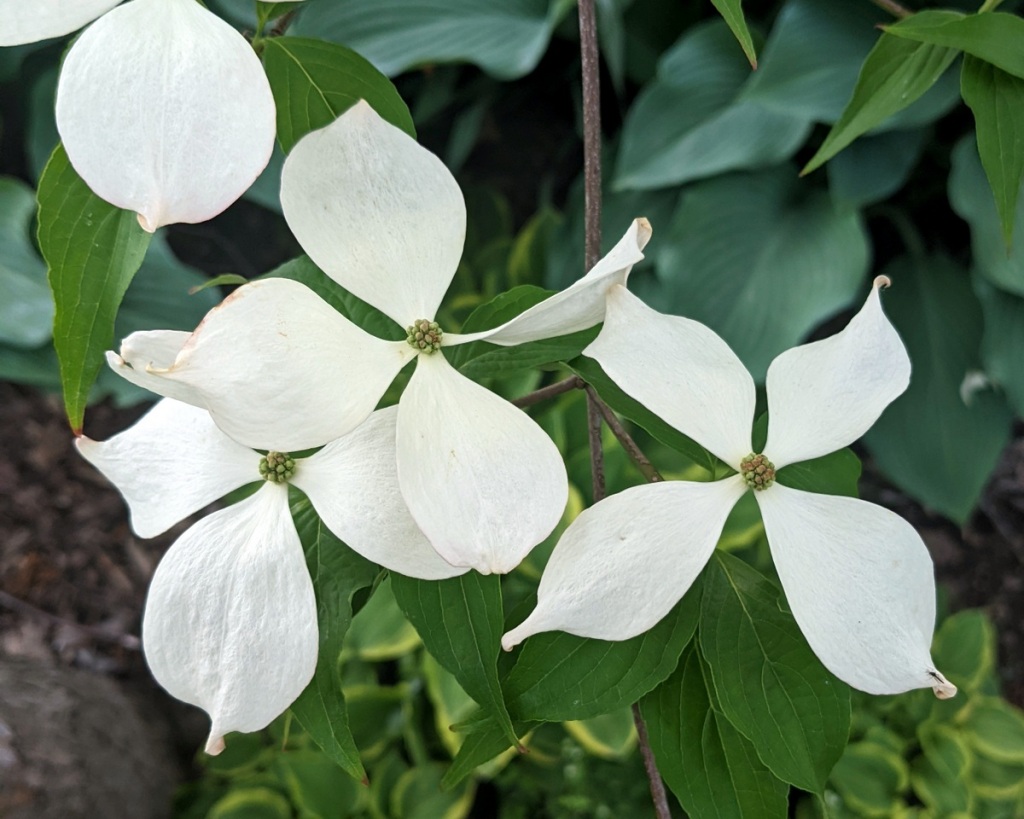
When you see dogwoods flowering you know it’s time to look for bunchberries, because being in the same family, they almost always bloom at the same time. Once again on this tree there are large white bracts surrounding the much smaller flowers in the center, just as we saw on the bunchberry.
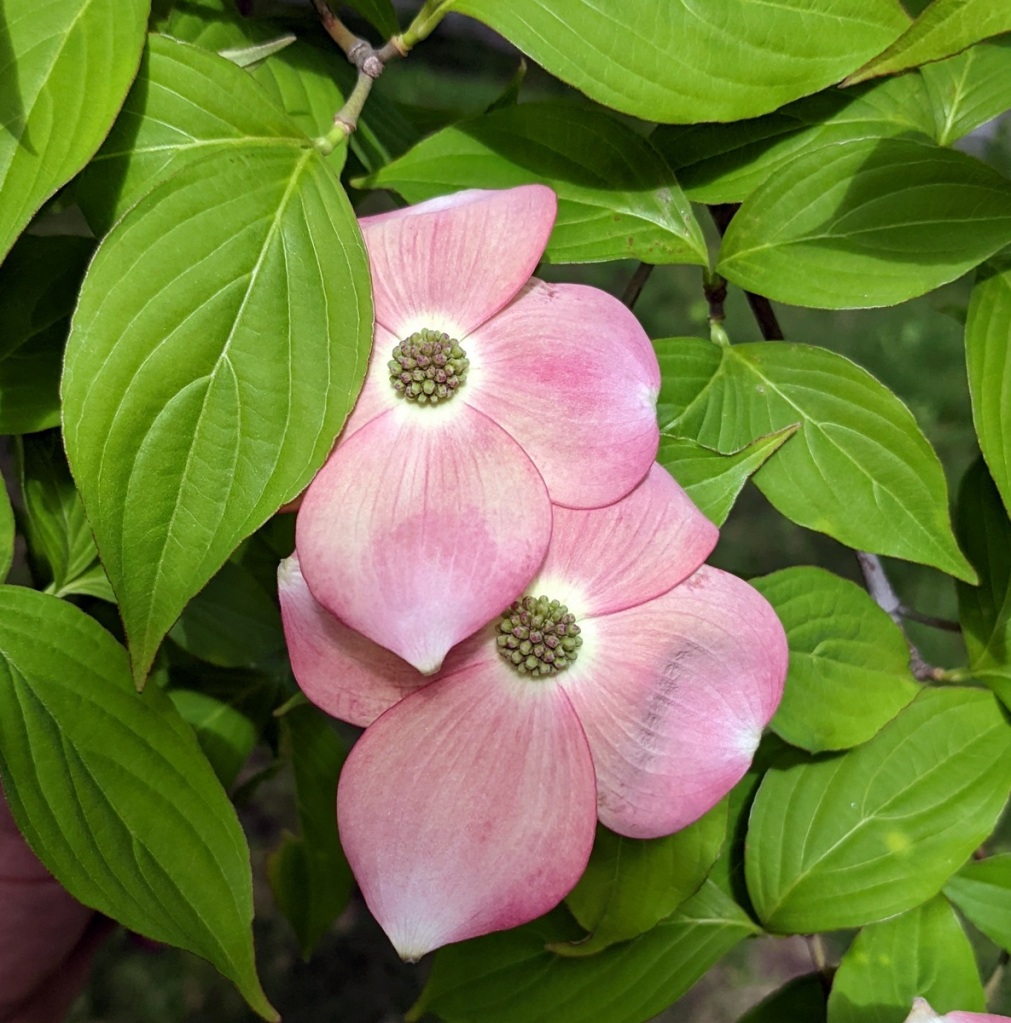
Some dogwoods were hit hard by the freeze we had on May 18th, as these blossoms show. The leaves don’t seem to have been bothered though, so the trees should do okay. In certain areas many trees like catalpla and black locust had all their leaves and flower buds killed or damaged by the freeze so we’ll have to wait and see how they recover. I should be seeing catalpa trees blossoming all over right now and I haven’t seen even one.
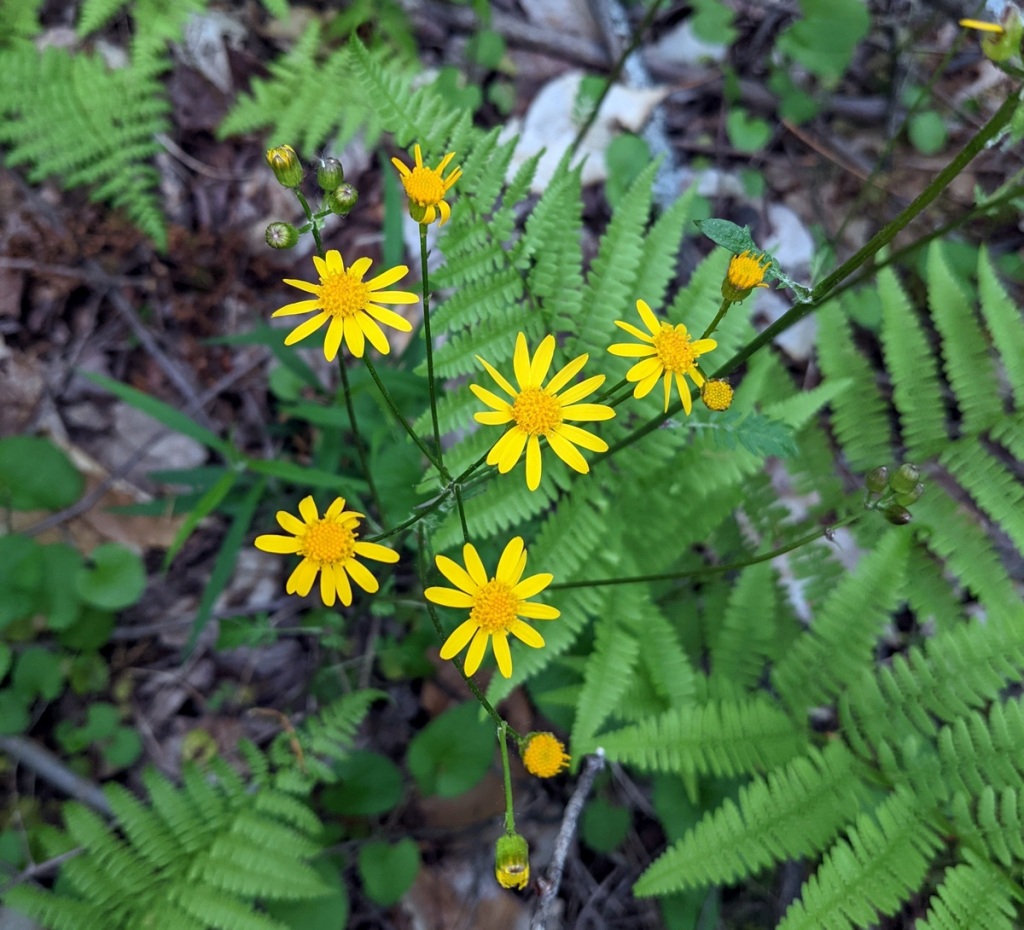
Golden ragwort is in the aster family and is considered our earliest blooming aster. It doesn’t mind growing in wet soil and tolerates shade so it always seems like a beacon with its bright yellow flowers shining in the dappled shade I find it in. It isn’t a common plant so I’m usually surprised by it as I was this time when I found it in a place I’ve walked by hudreds of times. It seems to be a plant that “gets around.” You’ll see it in a spot for a year or even three and then it will disappear, only to be found in a different spot.

Tatarian honeysuckle is one of the prettiest of the invasive honeysuckles, in my opinion. It is originally from Siberia and other parts of eastern Asia and in the fall its pretty pink flowers become bright red berries. Of course, birds eat the berries and the plant spreads quickly.

Morrow’s Honeysuckle is another invasive honeysuckle. It has sweetly fragrant, pretty white flowers that turn yellow with age. Unfortunately, it spreads by its berries like Tatarian honeysuckle and it can form dense thickets and outcompete native shrubs. It seems more aggressive than Tatarian honeysuckle and I see it far more often.
It’s a shame to have so many invasive plants and I would never make light of it, but the truth is once the genie is out of the bottle from what I’ve seen, it is nearly impossible to put it back in. Invasive honeysuckles have been around since I was just a small boy and I know that the only way to truly be rid of them is to dig them up and pull all the seedlings. But I can attest to the fact that digging up a honeysuckle is very hard work, and who will do it?
Does that mean we shouldn’t fight invasives? No, what I’m saying is, maybe Instead of setting out to “rid the world of the scourge” we should just be at peace with whatever we can accomplish. A lot of littles can add up to a lot. People seem ready to get together and “do the big thing” and then when they see more invasives growing where they’ve done so much hard work they get discouraged and give up. This is not the way to win. Everyone doing what they can when they can is the way to win.

An eastern swallowtail butterfly appeared to prefer the white Morrow’s honeysuckle but there were no tatarian honeysuckles in the area, so that probably isn’t a fair assesment. I doubt it has any real preference.

I hadn’t seen any dragonflies yet this spring so I went to Hancock one day, back to the nature camp I once worked for, just to take a walk and see what I could see. There is a pond there and there used to be so many dragonflies I had them land on me and even fly alongside the tractor when I mowed the meadow. They did that because they knew the tractor was going to scare up insects for them to eat. That’s when I discovered that dragonflies are not only smart but they must have at least a hint of a memory.

I spent some time at the pond hoping to see dragonflies, but didn’t see any. That’s because they were all here on this dirt road, apparently. Google lens says this one is a lancet clubtail, which likes to rest on gravel roads, so that fit. Two things bother me about that identification though; eye color, and the photo isn’t good enough to see the “tail.” If I understand what I’ve read this dragonfly’s eyes should be blue or gray, not brown. The color might just be caused by the harsh lighting though, because I’ve had trouble finding dragonflies of any kind with brown eyes online.
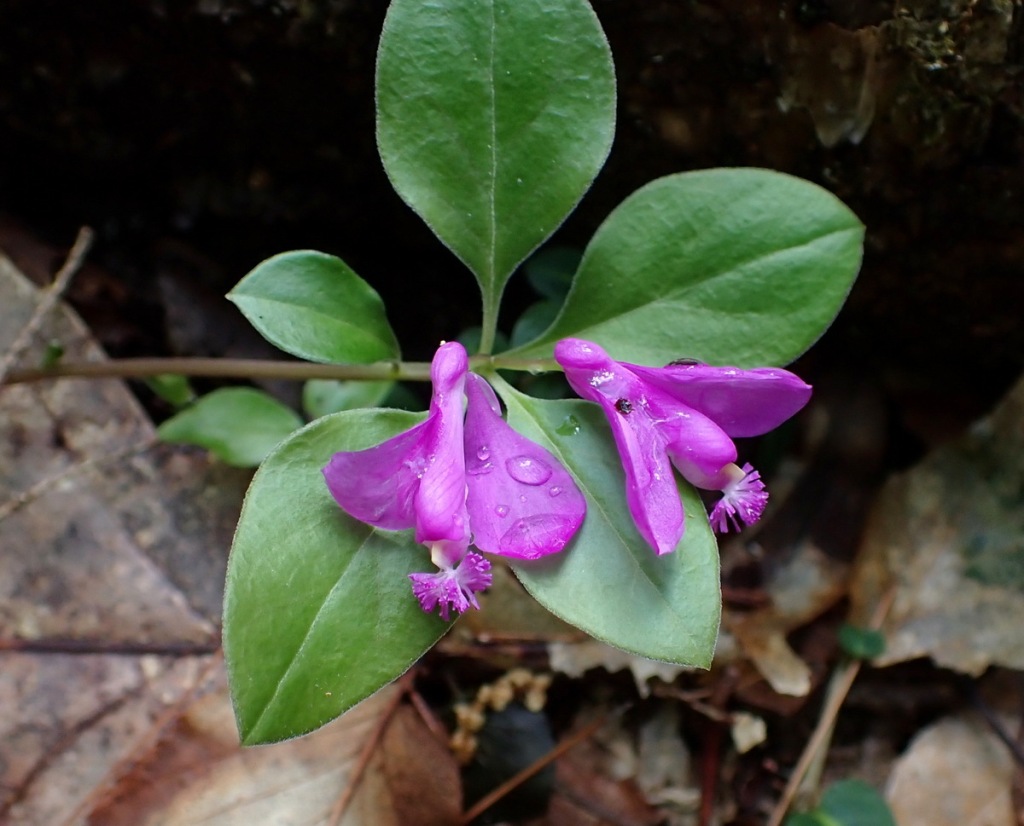
There were lots of fringed polygala at the camp when I worked there but I didn’t see many this time so I went to another spot and found these. These plants are in the milkwort family and aren’t really common but if they like a spot they can grow into a good size colony. I could explain how they’re pollinated but it’s quite a convoluted process so I’ll just ask that you trust me; they are pollinated. And it all starts when a heavy enough insect lands on that little fringe.
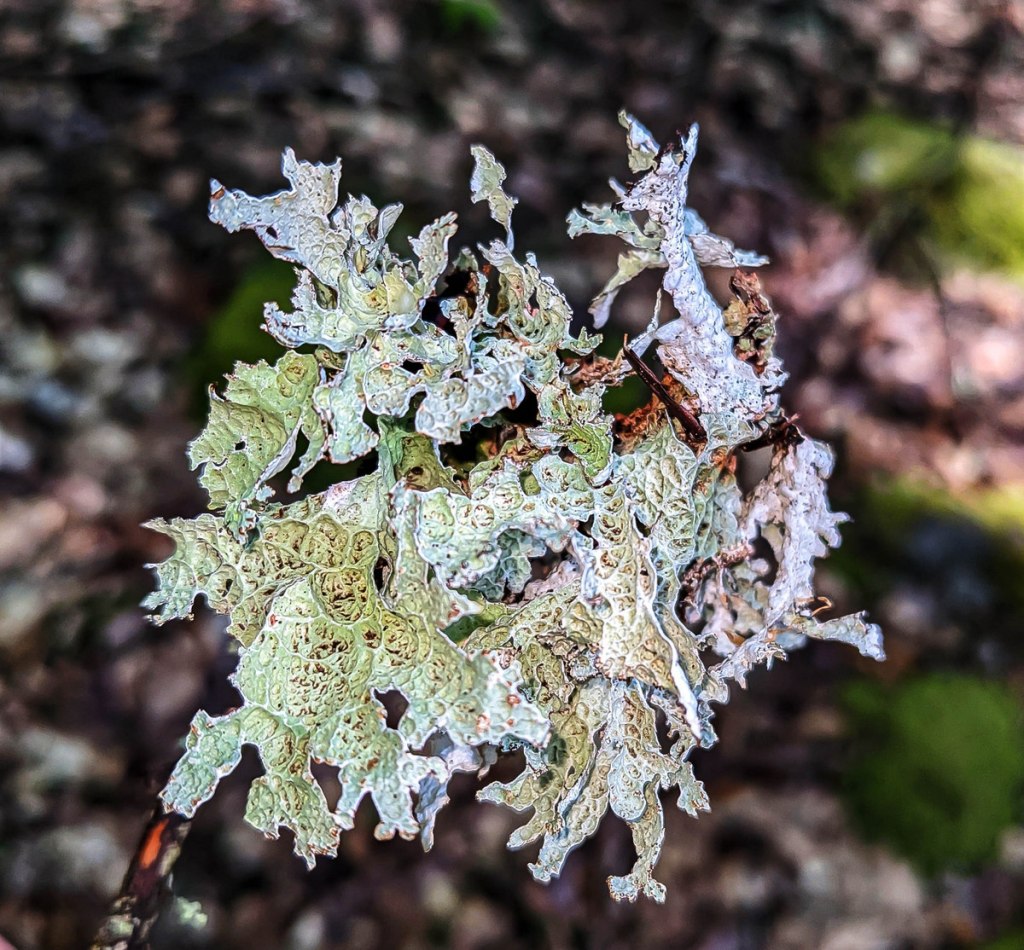
When I was looking for winged polygayla flowers I found a rag lichen. Despite a recent rain it was quite dry and, as is often the case with lichens, most of its color had changed as it dried. It wasn’t its color that I was interested in though; it was its amazing net like texture. This is the first time I had seen this lichen so I spent quite a lot of time getting photos of it. If you click on the photo you’ll be better able to see what I mean about its texture.
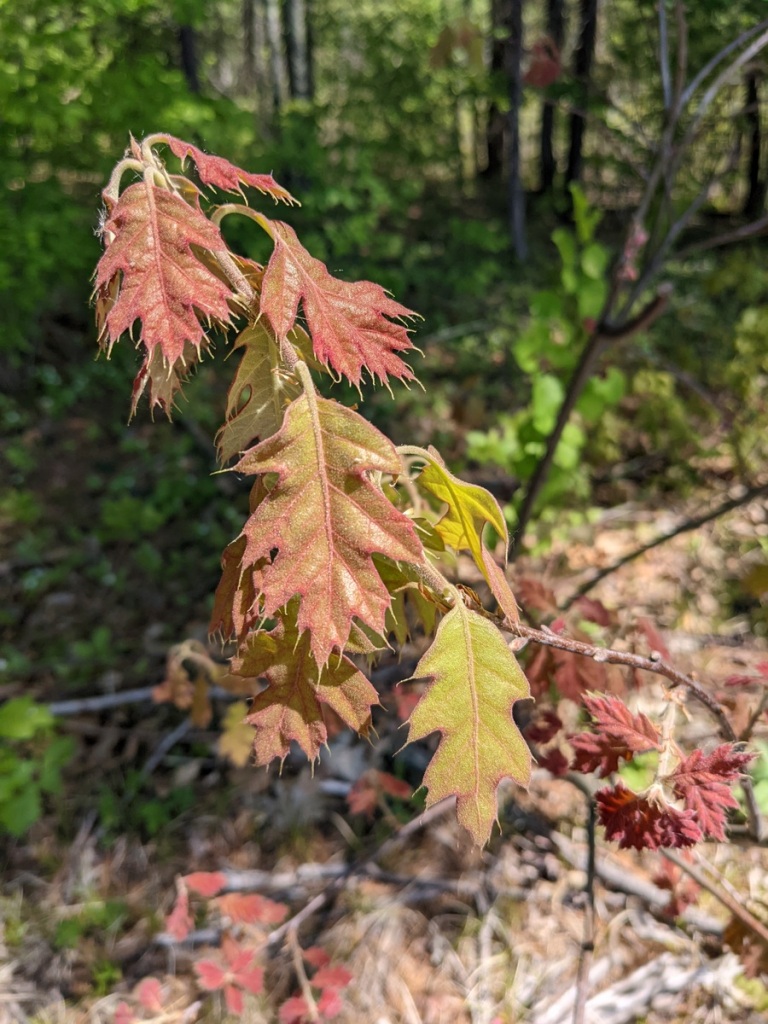
I thought I’d show one more shot of new spring oak leaves. They’re probably the last I’ll see this year. This shot shows how they finally turn green while still wearing their velvet coats. Once green and photosynthesizing they’ll lose their velvet and shine.
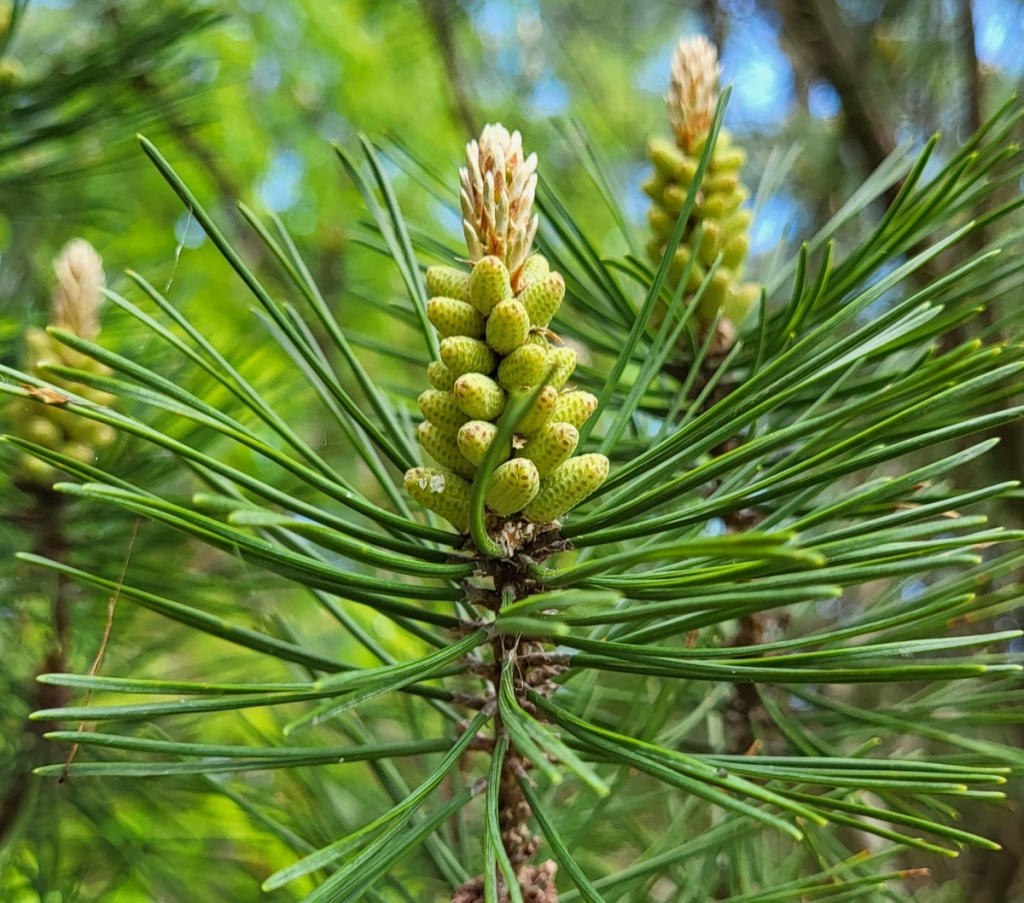
The male flowers of pine trees are called pollen cones because that’s what they produce. Pine trees are wind pollinated and great clouds of pollen can make it look like the trees are burning and releasing yellow green smoke each spring. Pine pollen is a strong antioxidant and it has been used medicinally around the world for thousands of years. Its health benefits were first written of in China nearly 5000 years ago and they were said to be numerous. You can still buy it today.

I love to see Robin’s plantain, which is one of the fleabanes, bloom in spring because it reveals all the flower lovers among us who, rather than mow it down, leave it to bloom. It is a common “weed” that comes up in lawns everywhere but it’s beautiful, so you’ll see large islands of unmowed grass with pink flowers poking up out of them on otherwise manicured lawns. For a week or so the weeds win and it always makes me smile. If only people could understand that it is these “weeds” that are normal, not their lawns. There was a time when grass was the weed, and it was dug up so the weeds, mostly used for food or medicine, would have more room to grow. The world must have been even more beautiful then.
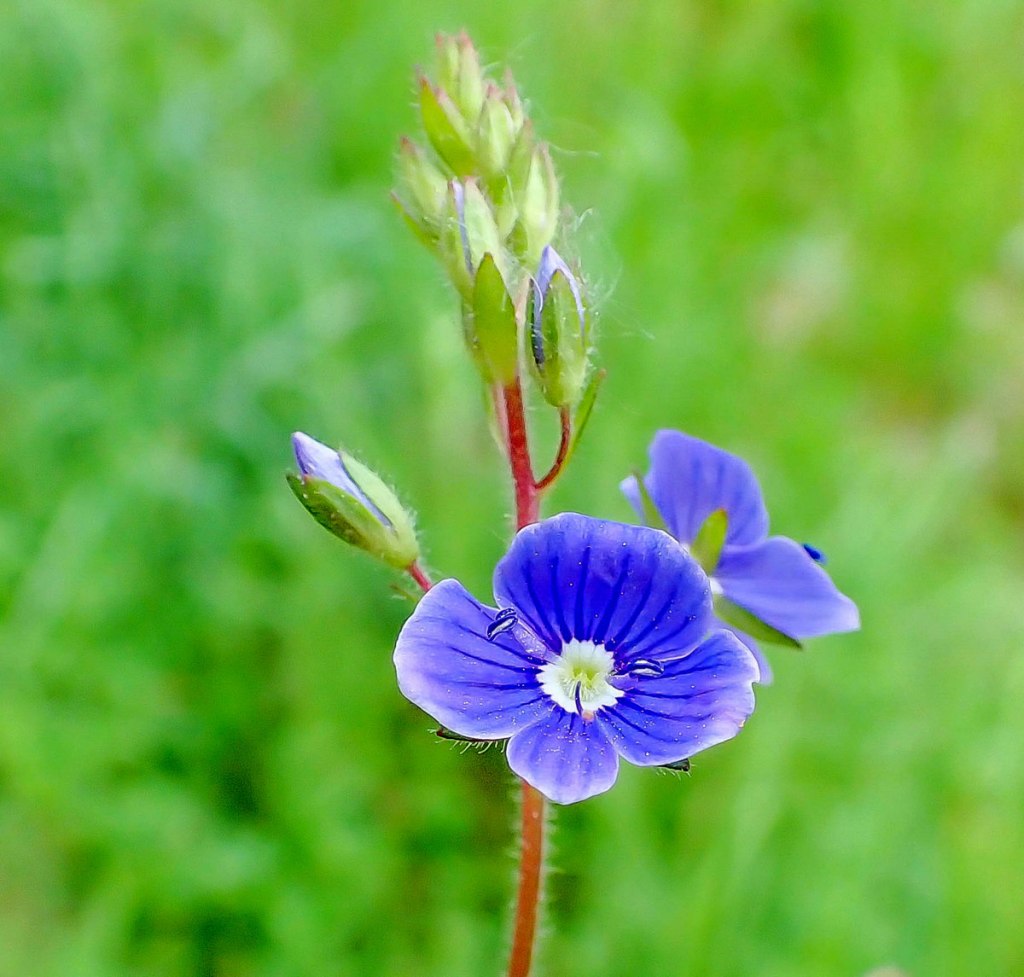
Germander speedwell is another beautiful weed that is one of the larger flowered “lawn” speedwells. It is also called bird’s eye or cat’s eye speedwell and is considered invasive but I always find it growing in the unmown grass at the edge of the woods, so I don’t know why it would be a bother. It can make rather large colonies so maybe if it got into the garden it could be a pest, but after a lifetiime in gardens I’ve never seen it in one, so I say just enjoy its quiet beauty and let it be. I would welcome it in my own yard.

Lesser stitchwort is blooming among the tall grasses. This plant is originally from Europe and is also called common or grass leaved stitchwort. It likes disturbed soil and does well on roadsides, old fields, and meadows. The common name stitchwort refers to the plant being used in herbal remedies to cure the pain in the side that we call a stitch. The stellaria part of its scientific name means star, and these beautiful little stars twinkle all summer long, just about everywhere I go. They and so many other weeds call me out of the shade of the forests and into the sunny meadows. There is great beauty found in both places but I learned as a boy that a meadow was much easier to walk through. When I wanted sweet and soft rather than rough and tumble I chose a sunny summer meadow.
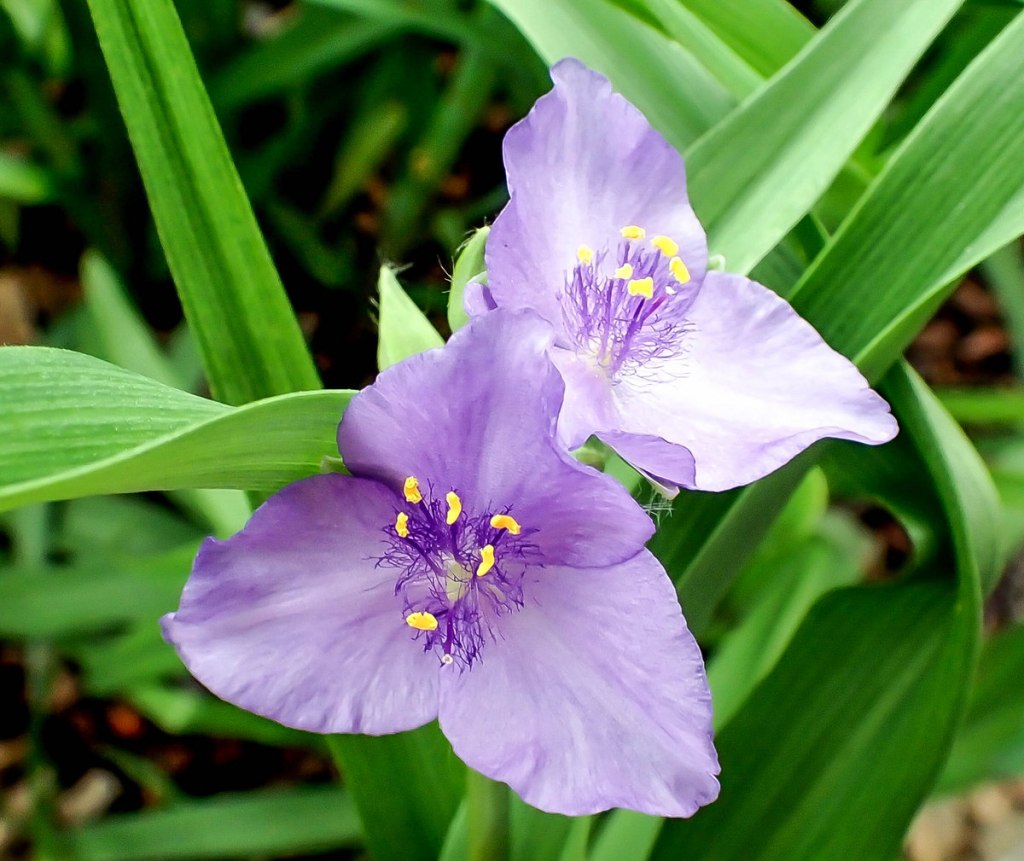
Tradescantia, also called spiderwort, has come into bloom. I took this photo because I thought I had found a pale blue one which I’d never seen, but my color finding software tells me it’s purple and I’ve seen plenty of those. I keep forgetting that I have a color blind helper app on my phone. It works well in the field but only if you remember to use it. The same could be said for the color blind glasses I have; they’re great, but you have to remember them.
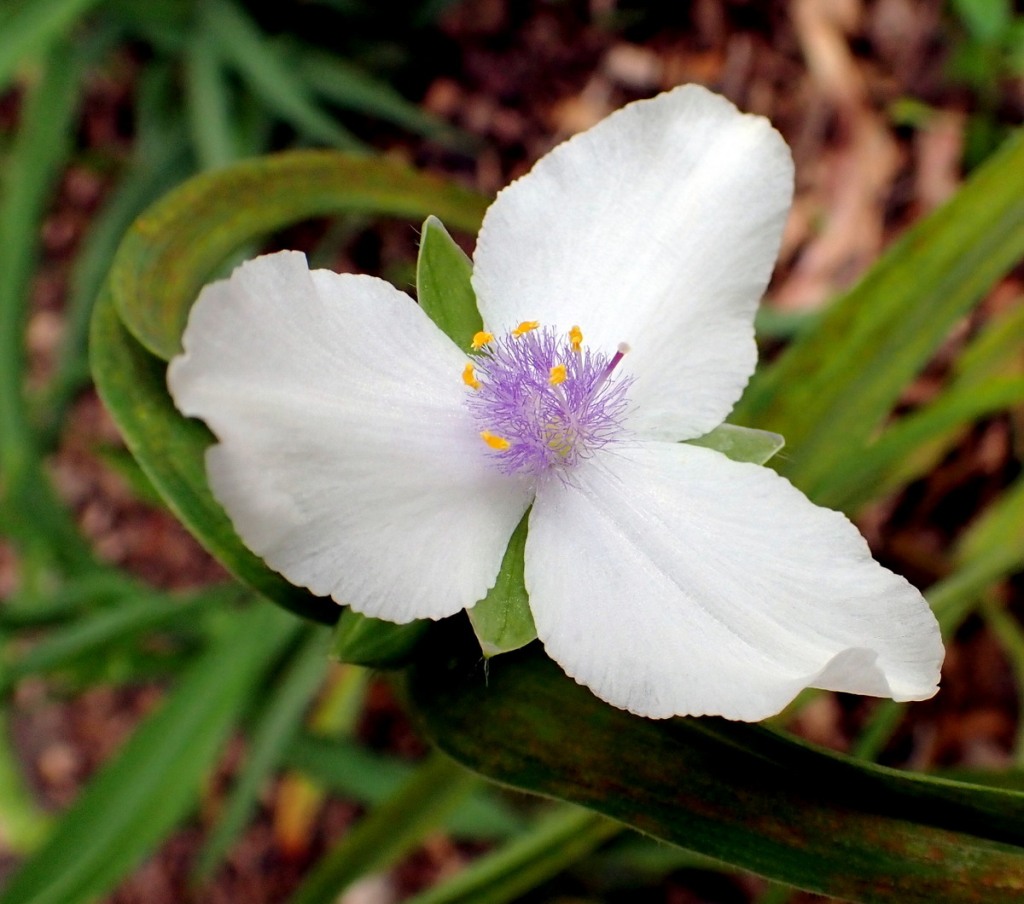
I was a little disappointed when I saw this white tradescantia blossom because last year it had blue streaks in its petals along with the blue in the center. It was a beautiful thing and it still is, but I do miss the blue in its petals. I looked at several different plants and all the flowers looked just like this one. If you’d like to see what I saw last year just Google “Tradescantia Osprey.” Apparently they can revert back to the solid white.
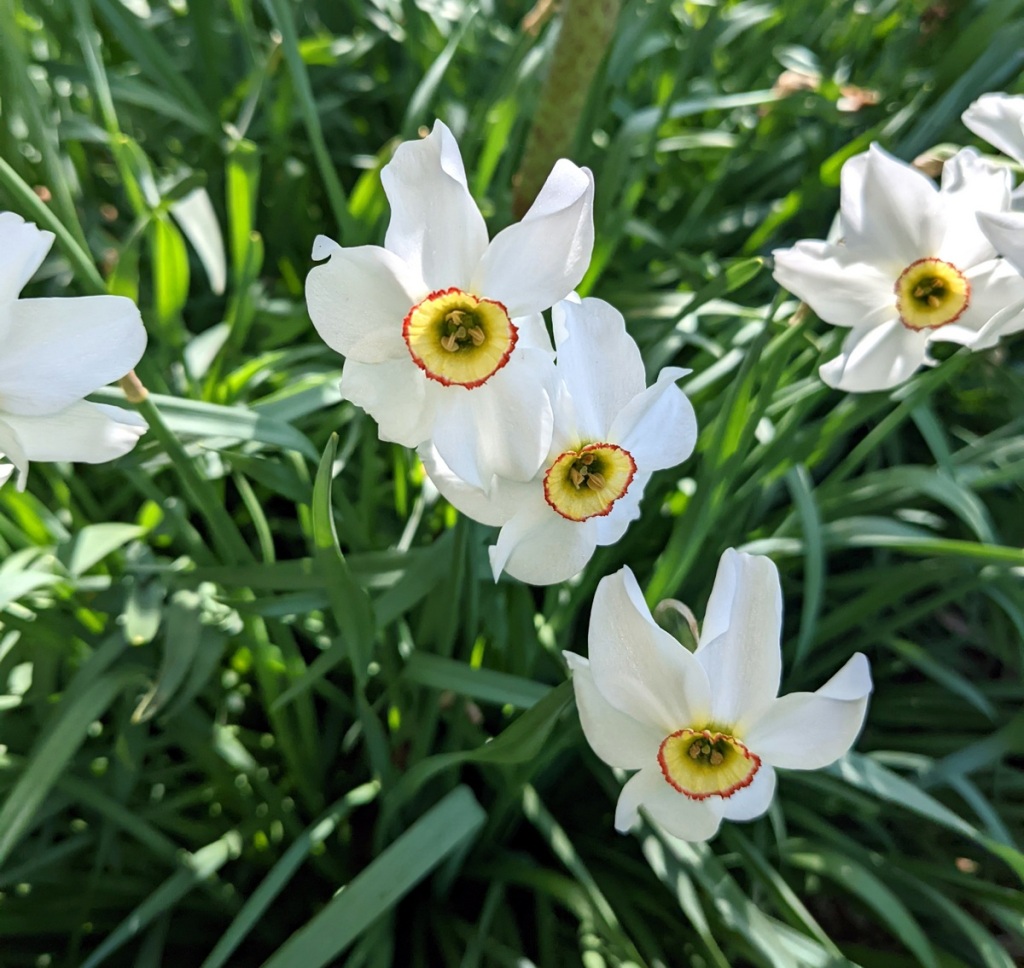
If you could somehow look back into the past to Ancient Greece at about 371 BC, you’d probably see this beautiful daffodil there. It’s called the poet’s daffodil and is such an ancient plant that many believe it is the flower that the legend of Narcissus is based on. It is one of the first cultivated daffodils and is hard to mistake for any other, with its red edged, yellow corona and pure white petals. It has naturalized throughout this area and can sometimes be found in unmown fields. Its fragrance can be compared to that of the paper white narcissus; so intoxicating that being in a room with 2 or 3 flowers in a vase can give some people headaches or make them sick. It blooms a bit later, just as most other daffodils are giving in. is also called the pheasant eye daffodil, for obvious reasons.
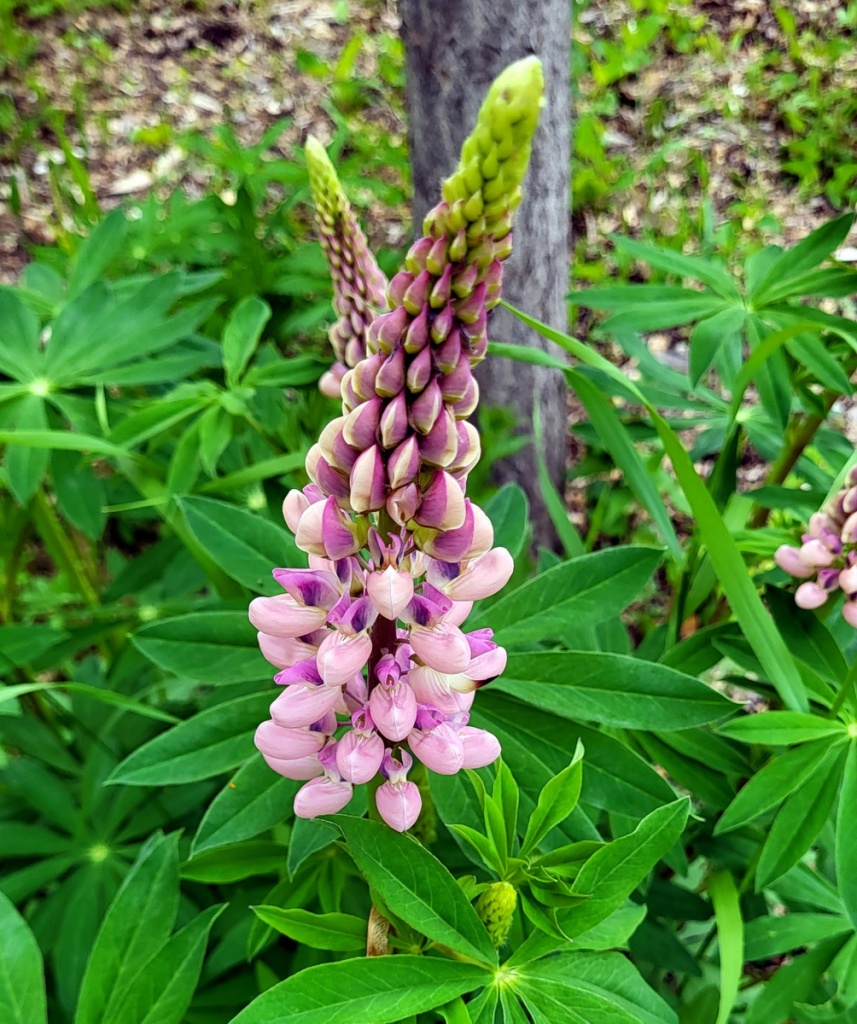
Lupines have just started blooming. I found this one at the local college. Anyone who has spent any time in a garden knows that lupines are in the pea / bean family. It’s a huge family of plants and you see its representatives just about everywhere.
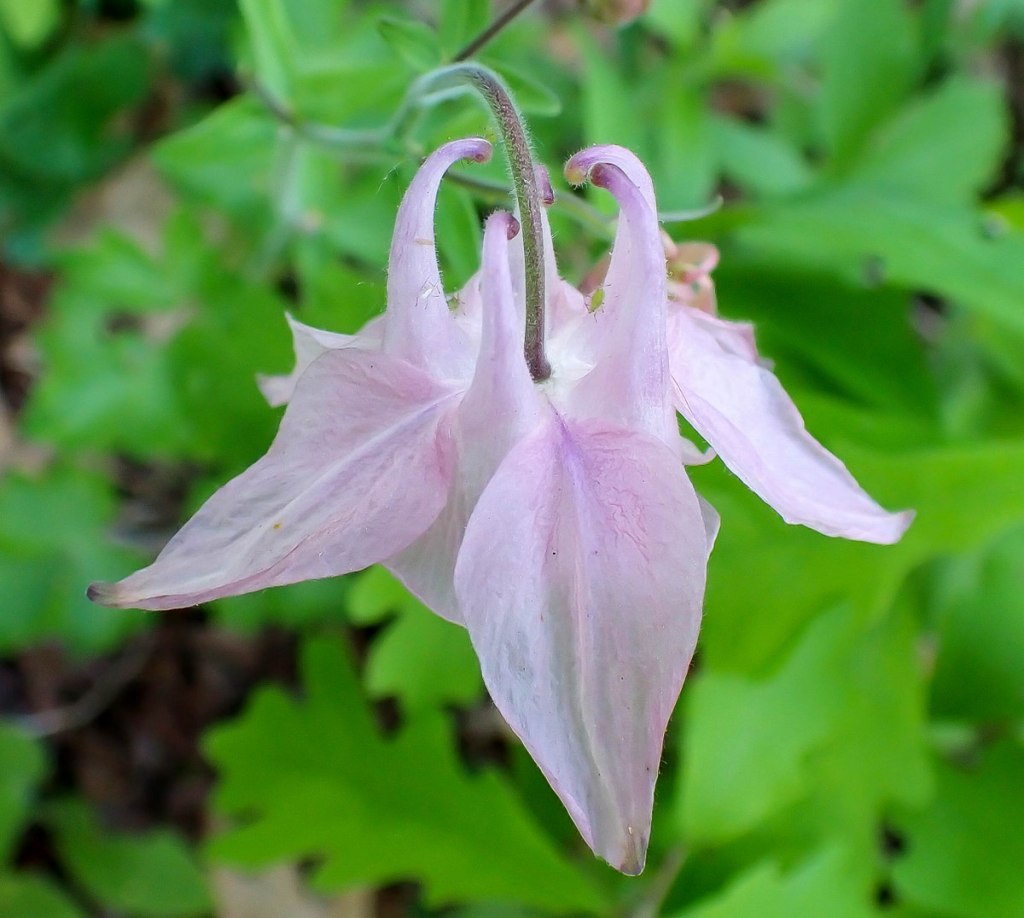
Five swans came together on the back of a columbine blossom.
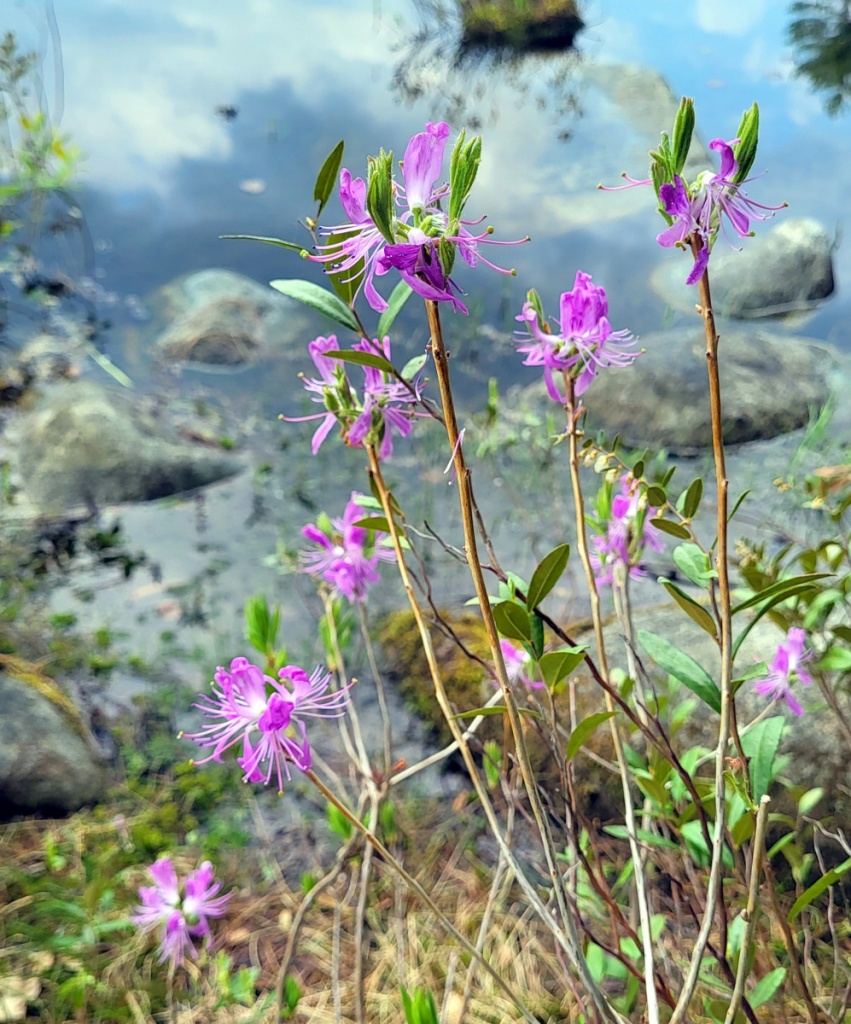
One of my favorite spring shrubs is the rhodora. It is a small, native rhododendron that loves swampy places. It’s native to the northeastern U.S. and Canada and its flowers appear before the leaves for a short time in late spring. By mid-June they will have all vanished. On May 17, 1854 Henry David Thoreau wrote “The splendid Rhodora now sets the swamps on fire with its masses of rich color,” and that is exactly what this beautiful little plant does.
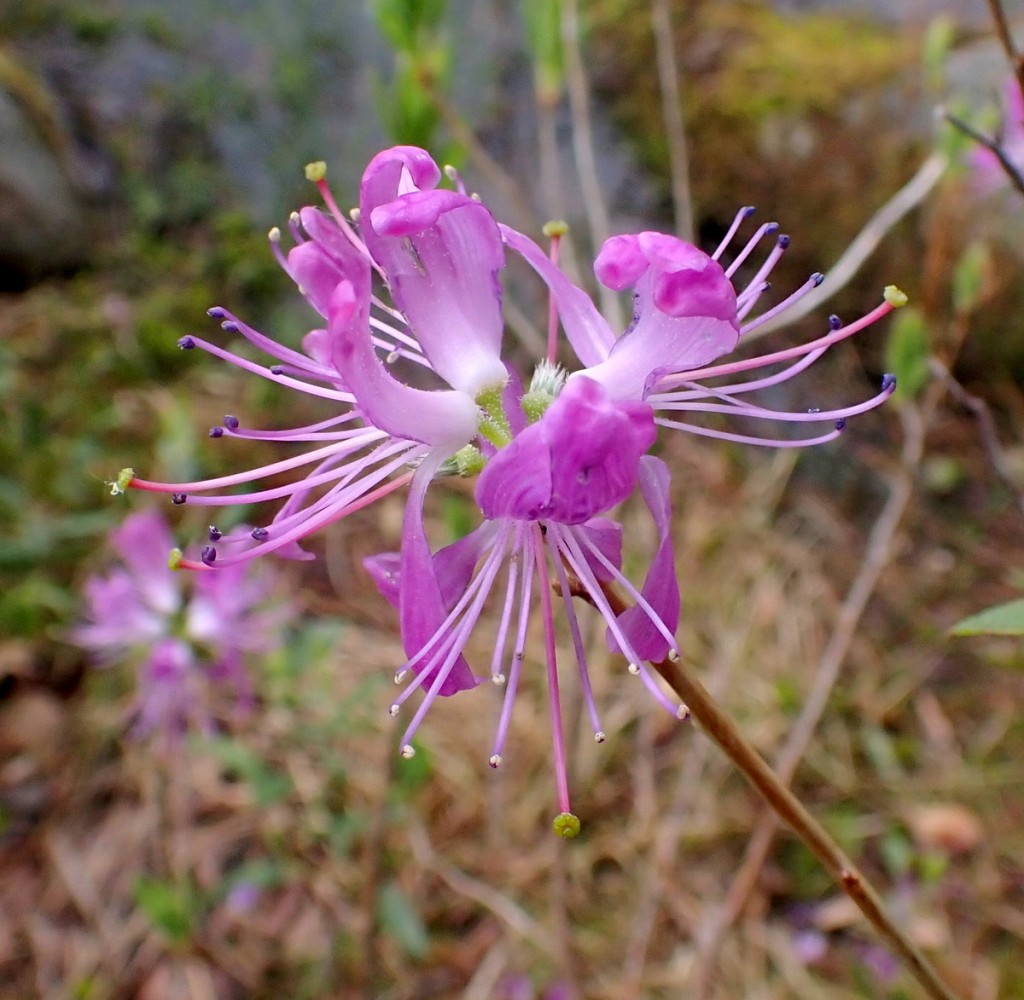
There’s nothing else quite like this flower blooming on pond shorelines in spring, so it’s close to impossible to confuse it with any other shrub. It often grows so close to the water that the best way to see it is by boat or kayak.
If you look the right way, you can see that the whole world is a garden. ~Frances Hodgson Burnett
Thanks for coming by.
Posted in Insects, Nature, Orchids, Wildflowers, tagged aquatic plants, Beauty in Nature, Blue Vervain, Canon SX40 HS, Elderberry, Floating Hearts, Forget Me Nots, Fragrant White Water Lily, Hancock New Hampshire, Keene, Keene New Hampshire, Native Plants, Nature, Nature Study, New Hampshire, NH, Olympus TG-6, Pickerel Weed, Pipewort, Rose Pogonia Orchid, Sheep Laurel, Spangled Skimmer Dragonfly, Summer Flowers, Summer Hiking, Summer Plants, Summer Wildflowers, Swamp Candles, Swamp Milkweed, Swanzey New Hampshire, Sweet Reed Grass, Water Arum, Water Lobelia, White Meadowsweet, Widow Skimmer Dragonfly, Wild Calla on July 13, 2022| 12 Comments »

I’m starting this post on aquatics with blue vervain (Verbena hastata,) only because I like its color. It isn’t a true aquatic but every time you find it there will be water very nearby. Blue vervain provides a virtual nectar bar for many species of bees including the verbena bee (Calliopsis verbenae.) Butterflies also love it. It likes wet soil and full sun and can reach 5 feet when it has both. I find it in wet ditches, on river banks and just about anywhere where the soil stays constantly moist.

Wild calla (Calla palustris) is also called water dragon or water arum, and it is a true aquatic. It is an arum like skunk cabbage or Jack in the pulpit, both of which also like wet places. I don’t know if I could say this plant is rare but it is certainly scarce in this area. It’s the kind of plant you have to hunt for, and you have to know its habits well to catch it in bloom. Like other arums its flowers appear on a spadix surrounded by a spathe. The spathe is the white leaf like part seen in the above photo. This plant is toxic and I’ve never seen any animal touch it.

I missed the tiny greenish white flowers this year. They grow along the small spadix and are followed by green berries which will ripen to bright red and will most likely be snapped up by a passing deer. This plant was in the green, unripe berry stage. One odd fact about this plant is how its flowers are pollinated by water snails passing over the spadix. It is thought that small flies and midges also help with pollination, because the odor from the blossoms is said to be very rank.

Pickerel weed is having a bad year and gone are the beautiful ribbons of blue flowers along the river’s banks. I’m not sure what is causing such a sparse bloom but I hope it rights itself because large masses of this plant in bloom can be truly spectacular.

One of the things that always surprises me about pickerel weed is its hairiness. I don’t expect that from a water plant. Its small blue / purple, tubular flowers on spikey flower heads will produce a fruit with a single seed. Once the flowers are pollinated and seeds have formed the flower stalk will bend over and drop the them into the water, where they will have to go through at least two months of cold weather before being able to germinate. If you see pickerel weed you can almost always expect the water it grows in to be relatively shallow and placid, though I’ve heard that plants occasionally grow in water that’s 6 feet deep.

I haven’t seen any berries yet but elderberries (Sambucus nigra canadensis) have bloomed well this year so we should have plenty. This is another plant that doesn’t grow in water but it grows as close as it can to keep its roots good and moist. This native shrub can get quite large and its mounded shape and flattish, off white flower heads make it very easy to identify, even from a distance.

A floating plant that is attached by roots to the pond or lake bottom is an aquatic, and that description fits floating hearts (Nyphoides cordata) perfectly. Floating hearts have small, heart-shaped, greenish or reddish to purple leaves that are about an inch and a half wide, and that’s where their common name comes from. The tiny but very pretty flowers are about the size of a common aspirin and resemble the much larger fragrant white water lily blossom. They grow in bogs, ponds, slow streams, and rivers. This flower was having trouble staying above water because it had rained and the water level had risen.

Forget me nots are not an aquatic plant but I keep finding them in very wet places. This one grew right at the edge of a pond so its roots must have been at least partially in water. The ground they grew in was also so saturated my knees got wet taking this photo. Many plants that are thought of as terrestrial are able to tolerate submersion in water and can live where they’re exposed regularly to water and from what I’ve seen, this is one of them.

Water lobelia (Lobelia dortmanna) is probably the rarest of all the aquatics that grow in this area. I still know of only one pond it grows in and there are only a handful of them there. I’ve read that the plant has the unusual ability of removing carbon dioxide from the rooting zone rather than from the atmosphere. It is said to be an indicator of infertile and relatively pristine shoreline wetlands. This year I saw only 4 or 5 plants in a small group. The small, pale blue or sometimes white flowers are less than a half inch long and not very showy. They have 5 sepals and the base of the 5 petals is fused into a tube. The 2 shorter upper petals fold up. I’ve read that the flowers can bloom and set seed even under water. True aquatic plants are plants that have adapted to living in aquatic environments (saltwater or freshwater) and this one has adapted well.

I saw a strange looking bubble which had ripples coming from it, as if it were moving. It was in a pond, just off shore.

Of course if you go looking for aquatic plants, you’re going to see dragonflies like this widow skimmer.

I’m also seeing lots of what I think are spangled skimmers this year. On this day all of them were watching the water.

Pipewort plants (Eriocaulon aquaticum) are also called hatpins, and this photo shows why perfectly. Pipewort plants have basal leaves growing at the base of each stem and the leaves are usually underwater, but falling water levels had exposed them here. Interestingly, this photo also shows the size difference between a floating heart, which is there in the center, and a standard water lily leaf, which you can just see in the top left. Floating hearts are tiny in comparison.

Pipewort stems have a twist and 7 ridges, and for those reasons it is called seven angle pipewort. The quarter inch diameter flower head that sits atop the stem is made up of minuscule white, cottony flowers. I think it’s interesting how their leaves can photosynthesize under water.

Sometimes it doesn’t matter if there are any flowers in view. The light is enough.

I saw what I thought was a pretty clump of grass right at the very edge of the river bank but when I looked closer, I saw that it wasn’t any grass that I had ever seen before and I think it is reed sweet-grass (Glyceria maxima,) which is invasive. It is native to Europe and Western Siberia and is a semi-aquatic, perennial grass with unbranched stems that get up to 8’ tall. There is a reddish tint on the lower parts of the stems. This plant towered up over my head but I can’t swear it had red on the stems because I have trouble seeing red. Reed sweet-grass invades wetlands and crowds out natives, and is not suitable for nesting. It is also a poor food source for our native wildlife.

Meadowsweet (Spirea alba) grows in the form of a small shrub and is in the spirea family, which its flowers clearly show with their many fuzzy stamens. It’s a common plant that I almost always find near water.

Meadowsweet flowers are fragrant and have a sort of almond-like scent. A close look shows that clearly, they belong in the spirea family. Before long their pretty purple cousins the steeple bushes will come along.

In my opinion swamp milkweed (Asclepias incarnata) is the most beautiful milkweed of all. It grows onshore but a few yards away from the water’s edge on land that rarely floods. Many insects were visiting it on this day. I know of only a single plant now, so I hope it produces plenty of seeds. The flowerheads always remind me of millefiori glass paperweights.

Swamp candles (Lysimachia terrestris) are not true aquatics but they do grow close enough to water to have their roots occasionally flooded. They are common along the edges of ponds and wetlands at this time of year. Their name comes from the way their bright color lights up a swamp, just as they did here.

Swamp candles have a club shaped flower head (raceme) made up of 5 petaled yellow flowers. Each yellow petal of a swamp candle flower has two red dots at its base that help form a ring of ten red dots around the five long stamens in the center of the flower. The petals are also often streaked with red and this is common among the yellow loosestrifes. Reddish bulbets will sometimes grow in the leaf axils. I’ve read that our native yellow loosestrifes were thought to have soothing powers over animals so people would tie the flowers to the yoke of oxen to make them easier to handle.

Pretty little sheep laurel (Kalmia angustifolia) will sometime grow in standing water but only when it rains and the water level rises. By choice they live right at the water’s edge. On the day I saw these I saw thousands of flowers blooming on the banks of a pond.

Here is a closer look at the flowers. Sheep laurel is part of the Kalmia clan, which in turn is part of the very large heath family, which includes rhododendrons, blueberries and many other plants. I know of only three Kalmias here and they are Mountain, Sheep and Bog laurel. The flowers of all three, though different in size and color, have ten spring loaded anthers which release when a heavy enough insect lands on the flower. It then gets dusted with pollen and goes on its way.

You can always tell that you’ve found one of the three Kalmias by looking at the outside of the flower. If it has ten bumps like those seen here you have found one of the laurels. Each bump is a tiny pocket that the tip of an anther fits into. If the flowers are anything but white it is either a sheep or bog laurel. If the flowers are white it’s a mountain laurel, though I’ve seen mountain laurels with pink flowers in gardens for the first time this year.

Fragrant white water lilies (Nymphaea odorata) are having a good year, I’m happy to say. They’re one of our most beautiful native aquatics. If you could get your nose into one you might smell something similar to honeydew melon or cantaloupe, but getting your nose into one is the tricky part.

I went to a local pond and saw what I thought were two-foot-tall white flowers on an island offshore. The pickerel weeds growing near the island told me the water could be up to six feet deep, so I certainly couldn’t wade out to them. My only choice was the zoom on my beaten-up old camera so I put it on the monopod and gave it a shot. When I looked at the photo I was stunned to see that the flowers weren’t white, they were pink. That was because they were rose pogonia orchids (Pogonia ophioglossoides,) a most rare and beautiful flower that I had been searching for in the wild for probably twenty years. And here they were, at a pond I had visited a hundred times. Why had I not seen them before? Because I had never come to this exact spot on the shore at this exact time of year before. That’s how easy it is to miss seeing one of the most beautiful flowers found in nature in bloom.

I’m sorry these are such poor photos but if you just Google “Rose Pogonia” you will see them in all their glory. This is a fine example of why, once you’ve started exploring and studying nature you feel that you really should keep at it, because you quickly learn that right around that next bend in the trail could be the most beautiful thing you’ve ever seen. I hope you have found that this is true in your own walks through nature.
Away from the tumult of motor and mill
I want to be care-free; I want to be still!
I’m weary of doing things; weary of words
I want to be one with the blossoms and birds.
~Edgar A. Guest
Thanks for coming by.
Posted in Birds, Nature, Scenery / Landscapes, Things I've Seen, Wildflowers, tagged Beaver Tree, Blue Flag Iris, Canon SX40 HS, Fly Fishing, Hancock New Hampshire, Hobblebushes, Maple Leaved Viburnum, Native Plants, Nature, Nature Study, New Hampshire, NH, Olympus TG-6, Pale Corydalis, Peace, Rhodora Blossoms, Shadbush, Solomon's Seal, Spring Fern Fiddleheads, Spring Flowers, Spring Hiking, Spring in New Hampshire, Spring Oak Leaves, Spring Plants, Spring Tree Colors, Spring Wildflowers, Stony Pond Bottom, Trout Pond, Violets, Willard Pond on May 28, 2022| 19 Comments »

Every year around Halloween I go to Willard Pond over in Hancock to see what in my opinion, is some of the most colorful foliage in the region. Every year I tell myself that I’ll come back in the spring to see what it looks like then but I never have, until now. We’re going to be walking through a beautiful hardwood forest of oak, beech, and birch right along that shoreline over there behind that boulder.

Though the forest looked leafless in that previous shot there were plenty of spring leaves to see. This is the start of the trail that I follow. It is called the Tudor trail but I think I would have named it serenity, because that’s where it leads.

There were lots of new, velvety oak leaves.

Shadbushes (Amelanchier canadensis) still bloomed.

Ferns were in all stages of growth.

And everywhere you looked there were the big white flowerheads of hobblebushes (Viburnum lantanoides). It was hard to get a shot of them in the bright sunlight so I had to underexpose this shot. White is a tricky color for a camera on a sunny day. I’ve had several questions about cameras and how to use them lately and if this situation seems tricky for you, you might want to read about “bracketing exposures.” It’s a simple tip that covers a lot of bases and helps you get more used to changing the settings on your camera.

Another native viburnum, maple leaved viburnum (Viburnum acerifolium), showed how it got the name. In the fall these leaves can turn pink, purple, red, yellow, and orange and combinations of two or three, and are really beautiful. The Native American Chippewa tribe used the inner bark of this plant to relieve stomach pains.

The beavers had cut down a big beech and were in the process of stripping all its bark from it.

I stopped to look at the hillside across the pond with its soft, hushed hints of green. I saw what I had suspected; that this place is beautiful no matter what time of year it is. I could hear a loon laughing and giggling over there somewhere and I wondered what the early settlers must have thought when they first head loons. With all of their many superstitious beliefs it must have scared them half to death. If you’d like to hear what I heard, just click here: www.loon.org/the-call-of-the-loon/

A fly fisherman was fishing for trout from his kayak and he heard the loon too. The loon was most likely also fishing for trout. Willard pond is considered a trout pond and there are rainbow and brook trout, as well as with smallmouth bass. No boats with motors are allowed, and fly fishing is the only form of fishing allowed. Since it is part of a wildlife sanctuary the land surrounding the pond can never be developed. It is about as close to true wilderness as you can find in this area and it is beautiful.

Several times when I came here in the fall, I saw the seed heads of rhodora (Rhododendron canadense). They’re one of our most beautiful shrubs and I hoped to find them in bloom, but all I saw were buds. I had to go back to get these photos of them but it was worth it because this is not a common shrub.

Rhodora is a small, two-foot-tall native rhododendron (actually an azalea) that loves swampy places. It is native to the northeastern U.S. and Canada and both its western and southern limits are reached in Pennsylvania. The flowers appear just before the leaves, but only for a short time in spring. They bloom just before irises in this area, and by mid-June their flowers will have all vanished. Henry David Thoreau knew it well, and wrote “The splendid Rhodora now sets the swamps on fire with its masses of rich color.” He would have loved this place.

Solomon’s seal (Polygonatum commutatum) grew all along the trail and on some of the boulders. I saw plenty of buds but no flowers yet. In the fall dark blue or purple berries will hang where the flowers were.

I’m including this view of the trail to show that if you come here, you’d be wise to wear good sturdy hiking boots. Mud, stones and roots are some of the things you’ll have to scramble up and over. I tell you about trail conditions in these posts so you won’t get here and wonder what you’ve gotten yourself into. I often wish someone had done the same for me. Every hike has its own set of challenges, and their difficulty seems to increase with age.

For years, each fall I’ve seen what I thought was a species of dicentra growing on a boulder. But which boulder, I wondered on this trip. Then up ahead I saw that a tree had fallen across the path, stopped only by a boulder. When I got to the boulder sure enough, it was the boulder with the plant I was looking for on it. Luckily the tree hadn’t crushed the plants, so I was able to see them flowering. I could see that they weren’t dicentra.

Though I could see that they weren’t dicentra I didn’t know what they were because I had never seen them before. I took photos of the flowers and leaves from all sides as I always do and when I got home, I found that they were pale cordyalis. (Corydalis sempervirens.) They are a native which, from what I’ve read likes sandy, stony soil along pond and river banks. They are also called rock harlequin and why is perfectly clear, since this one grew on a boulder.

The small flowers of pale corydalis have two pairs of petals, which are bright pink with yellow tips. Some were white, but I’m not sure if they fade to white or come out white and turn pink. They are a biennial, which means that the plants appear in the first year and flower in the second. Flowers are small and appear in clusters (Racemes). They are related to Dutchman’s breeches, which is a native dicentra.

When I got home and saw this photo I took of the forest I thought my camera had lost its marbles, but then I checked the shots I took with the other two cameras I carried and they all showed the same; the most intense green I’ve ever seen. Colorblindness makes it hard to understand what color I’m seeing sometimes and sometimes the colors I see just don’t seem possible. “Find that on a color wheel” my mind taunts.

I’m always awe struck by this huge boulder. In relation to the glacier that scraped it up and brought it here it must have been little more than a grain of sand, and it’s hard to even imagine that.

Violets grew out of the moss on a stone at the water’s edge.

Blue flag irises grew close enough to the water to have wet feet, and that’s what they like. I haven’t seen any in bloom as of this post.

Over the years a few people have told me what I’ve missed by not following the trail past this old oak with its rickety little bench but I’ve seen, heard and felt enough, and I usually have more photos than I would want or need by the time I get here, so this is where I end my hike. I could go on to what is called “the point” or I could climb Bald Mountain, but I don’t feel a need to do so. This spot always calls to me to come and sit so that’s what I do, and it has always been enough.

I sit on the ground these days because the bench is getting wobbly, but it doesn’t matter. The view is the same and the sounds are the same. There is just the lapping of the waves and bird song, and maybe an occasional chuckle or hoot from a loon.

I watched the shadows from the waves move over the stone covered pond bottom. There was just enough of a breeze to kick them up a bit and thankfully, to keep the biting bugs away. In this region you would be hard pressed to find a day when there wasn’t a breeze coming across a lake or pond.

The one thing that is most abundant here is silence, and the simplest lesson nature teaches is the most valuable: silence heightens awareness. Once we have learned this silence becomes the teacher, and silence teaches peace. When I come upon the kind of beauty that makes me quiet and still, be it a tiny flower or a mountain top, I find that peace is always there, waiting. I do hope that you find the same.
The best places aren’t easy to see; instead of following light one must follow silence. ~Hanna Abi Akl
Thanks for stopping in.
Posted in Buds, Ice Formations, Nature, Scenery / Landscapes, Things I've Seen, Wildflowers, tagged Ashuelot River, Ashuelot River Waves, Beauty in Nature, Box Elder Buds, Box Elder Flowers, Canon SX40 HS, European Beech Seed Pods, Giant Rain Puddles, Graffiti, Halfmoon Pond Hancock, Hancock New Hampshire, Ice Formations, Johnny Jump Ups, Keene New Hampshire, Maple Sap Buckets, Mineral and Bacteria Seep, Native Plants, Nature, Nature Study, New Hampshire, NH, Olympus TG-6, Red maple Buds, Reticulated Iris Shoots, Skunk Cabbage, Skunk Cabbage Swamp, Spring Flowering Bulbs, Spring Flowers, Spring Hiking, Spring in New Hampshire, Spring Plants, Swanzey New Hampshire, Vernal Witch Hazel Flowers, Waterfalls in Winter, White Puddle Ice, Winter Hiking, Winter Ice Formations, Winter Plants, Winter Woods on February 26, 2022| 19 Comments »
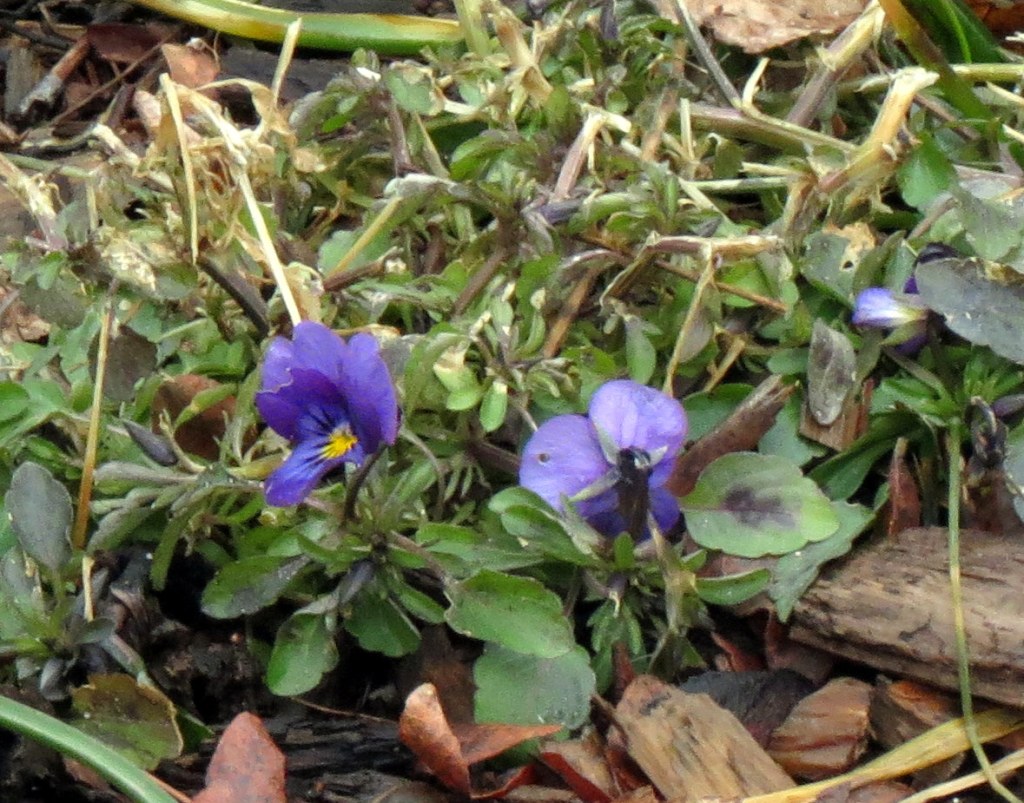
The roller coaster changes between winter and spring go on in this area. Yesterday I was taking photos of Johnny jump ups and today as I write this it is 30 degrees F.

But the cold won’t hurt the early spring plants any, especially those in the pansy family like viola tricolor. They’re hardy, and built for cold finicky weather, and that’s why you’ll often see them blooming away beautifully in window boxes in March. I have to say I was quite surprised to see them blooming in February though. I think that is a first, but after two or three days in the 50s they responded. This is why, when I talk about spring on this blog, I’m not talking about calendar spring. I’m talking about the spring that the plants and trees and birds tell me is here now.

Except for an ice shelf over there on the left the ice has melted off the stream that runs through the skunk cabbage swamp. It was blue and beautiful on a sunny day.

And the skunk cabbages are growing quickly. Soon the spathes like the one seen here will open to reveal the spadix, which will be covered in tiny, pollen bearing flowers.

It rained hard the night before this was taken and instant ponds popped up everywhere. That’s a good sign that the soil under them is still frozen. Since the water can’t soak into the ground and has nowhere to go it ponds up in the low spots. This one was huge and I was surprised there were no ducks in it.

After it started to cool off again, I went to a waterfall to see if any ice had formed. I wasn’t disappointed.

Everything on the shoreline was covered with ice.

This grass plant had grown ice on its leaves that was thicker than my thumb, all from splashing drops of water. When I see ice like this I think of a candle. A candle starts with a wick, which is dipped again and again into melted wax. In this case each blade of grass is like a wick, splashed over and over by water.

This stone was covered in round spheres of ice. I can’t explain the mechanics of how this ice forms but I do know that splashing water creates it.

There was also plenty of white puddle ice to be seen. I’ve read that it is oxygen that makes the ice white like this. Microscopic bubbles, I suppose. It held the memory of what looked like a current.

This was a surprise and it was flowing right out of the ground just where I stood. I thought it was bright red but my color finding software sees rosy brown, chocolate and dark salmon pink. Though it looks strange it’s really just groundwater that has leeched out various minerals in the soil. Most of those minerals I’d guess, are iron oxide based. There are probably bacteria present as well and I’d guess that the heavy rain we had flushed everything out of a groundwater reservoir of some kind. Scientists say it’s all non toxic and harmless, but I admit it doesn’t look it.

I can remember as a boy seeing the Ashuelot River run almost the color of that seep in the last photo, when the woolen mills in Keene released their dyes into it. It ran all the colors of the rainbow, but when I need to think of a good success story I think of the river, because over the years it was cleaned up. Now trout swim in it once again and bald eagles fish here. We humans can accomplish quite a lot when we put our minds to it.

The river looked fairly placid in that previous shot but this is what was going on downstream. The camera made the water look dark but it was really chocolate brown from all the soil that is washing into it from flooding. This section looked to be about twice its normal width and it roared mightily.

Instead of a roar the ice on Halfmoon Pond in Hancock pings, creaks and twangs, especially when the wind blows. It was covered in melt water recently and looked like a mirror. It will freeze and thaw until one day, it won’t freeze any longer. I still think that ice out will happen in March this year.

When warm air flows over the cold ice sometimes the pond creates its own fog. Just another hint of spring that I enjoy seeing.

The witch hazels didn’t dare to unfurl their petals on this cold day. It’s kind of amazing how they can pull their long strap shaped petals back into such tiny buds but they’re fairly accurate. I’ve seen them get frost killed in the past but that doesn’t happen often. Each fuzzy bud that the petals come out of is less than the diameter of a BB that you would put in an air rifle. That’s 0.177 inches so I’d guess the buds are about an eighth of an inch, or .125.

The reticulated iris (I think) had grown some in the week since I had seen them last, and so had the daffodils. The seed pods you see are from redbud trees. These spring flowering bulbs grow under them.

Tree buds were calling to me as they always do in spring but I couldn’t see any signs of swelling in the pretty blue buds of the box elders. This tree in the maple family has beautiful flowers in spring so it’s always one of those I check regularly. They’ll bloom just after the red maples do.

These are the beautiful sticky, lime green female box elder flowers, for those who haven’t seen them. I’ll be waiting impatiently for both them and the red maple flowers. Box elders usually flower in April and red maples sometimes by mid-March. It all depends on the weather.

Speaking of red maples, here are some of their flower buds. I can see a little movement in them. The bud scales are starting to ease and open but I hope they won’t because it’s too early. I’ve seen trees with every flower killed by frost but nature has that all figued out, and not all trees bloom at the same time. The bloom times are staggered over several weeks, so if a killing frost happens not all tree flowers will be damaged by it.

I walked past the European beech I know of in Keene and saw its seed pods all over the ground, falling I suppose, to make room for new ones.

They were all empty, even the ones still on the tree. No wonder there are so many happy squirrels in that area.

Many, many years ago someone went around Keene with a stencil of a foot and spray-painted small feet here and there throughout town. I was surprised to find one still in good condition one day. It told me to stay on the trail. Keep walking and keep seeing the wonders.

It doesn’t take much to make my heart soar in spring; seeing sap buckets hanging on the sugar maples will do it every time. Though this post might seem to be all over the place, with flowers and ice and snow, that’s what spring is in New Hampshire. We are in the push-pull transition time between winter and spring and right now, winter is making a comeback. We are expecting a foot of snow as I finish this post, but it won’t last long and spring will win out as it always does. The trees producing sap means the ground has thawed and soon everyone will be wearing a smile. If you ask most of them why they’re smiling chances are they won’t be able to tell you but it’s just that spring tonic. It just makes you happy, for no particular reason.
The first day of spring is one thing, and the first spring day is another. The difference between them is sometimes as great as a month. ~Henry Van Dyke
Thanks for stopping in.